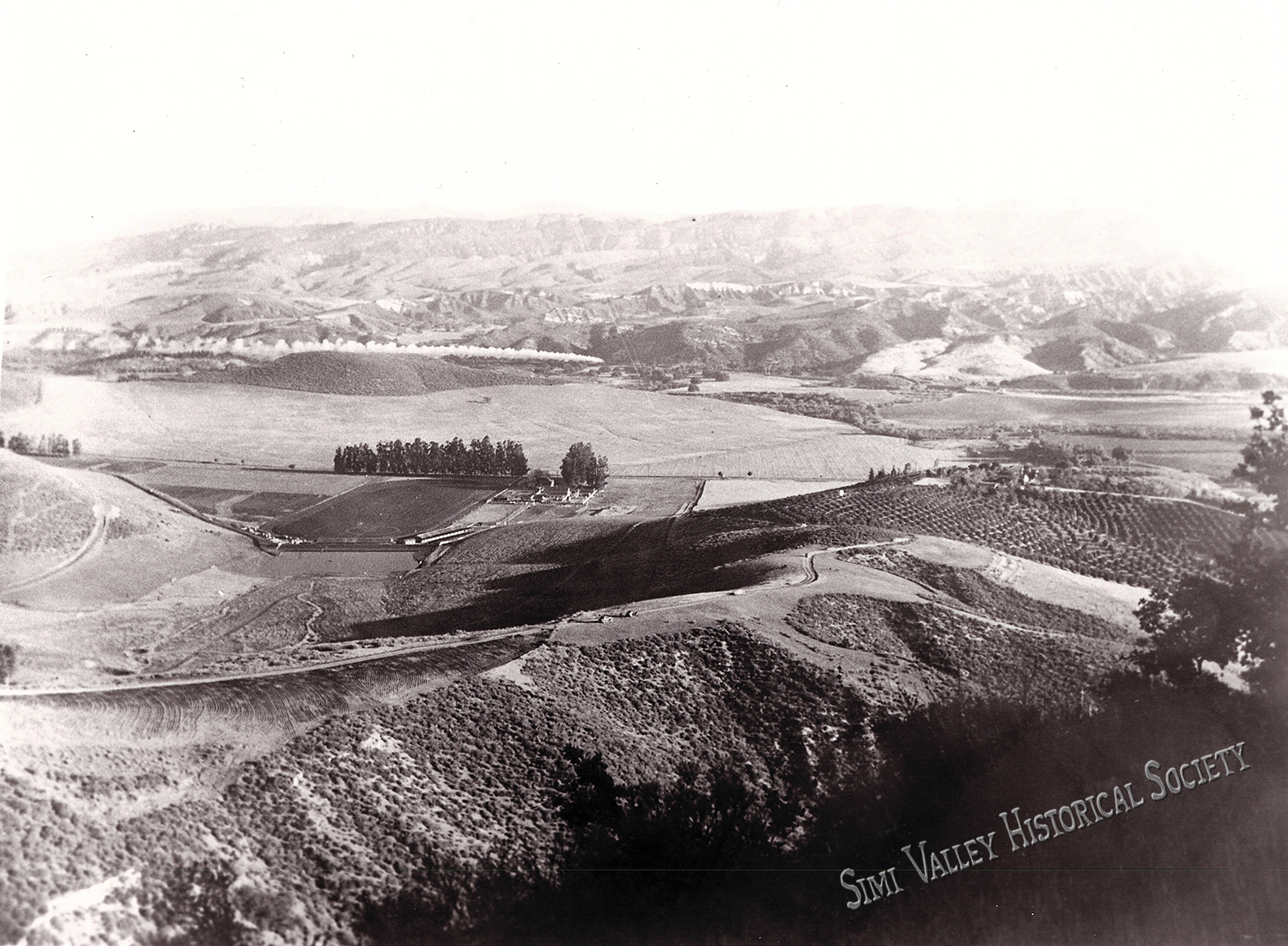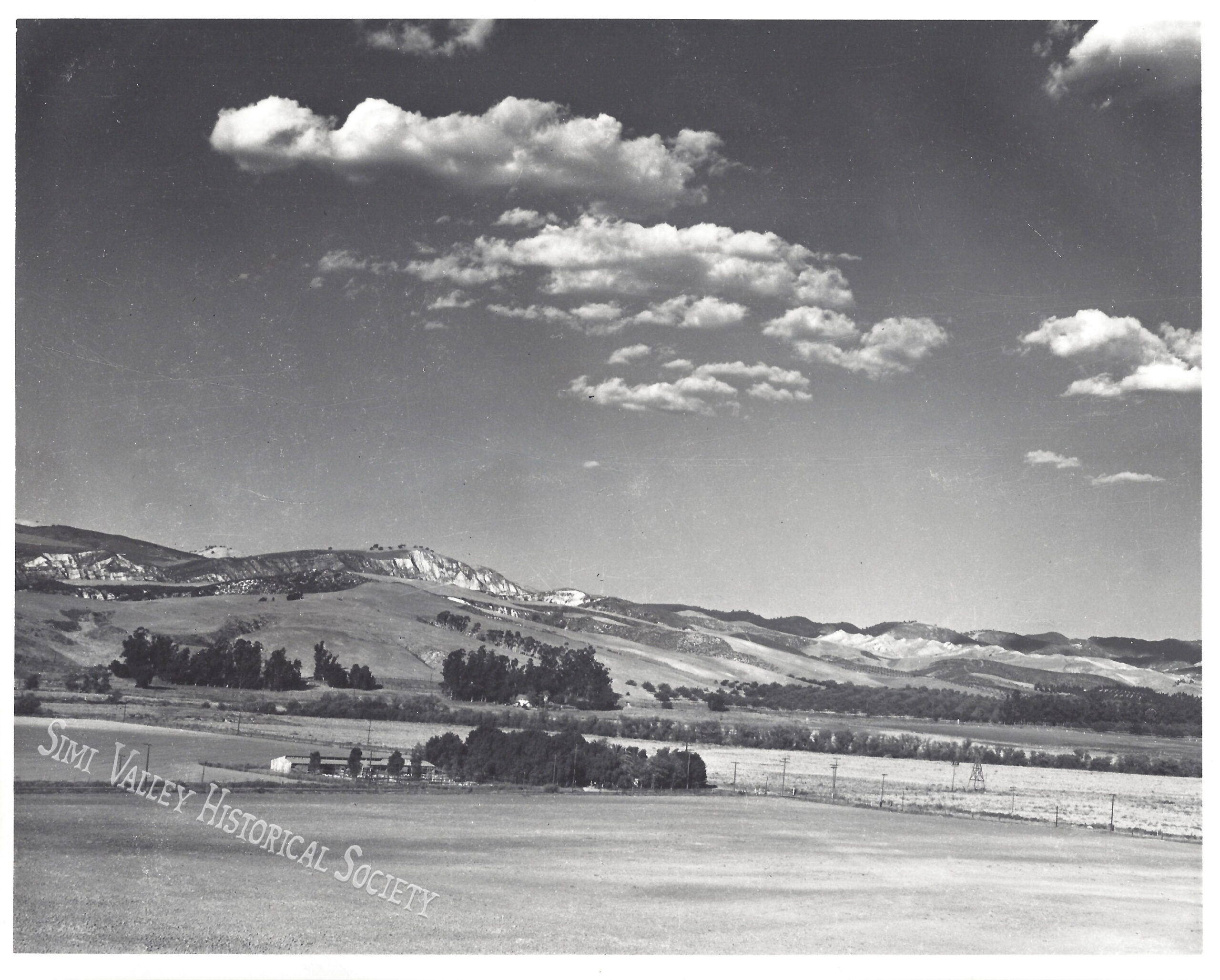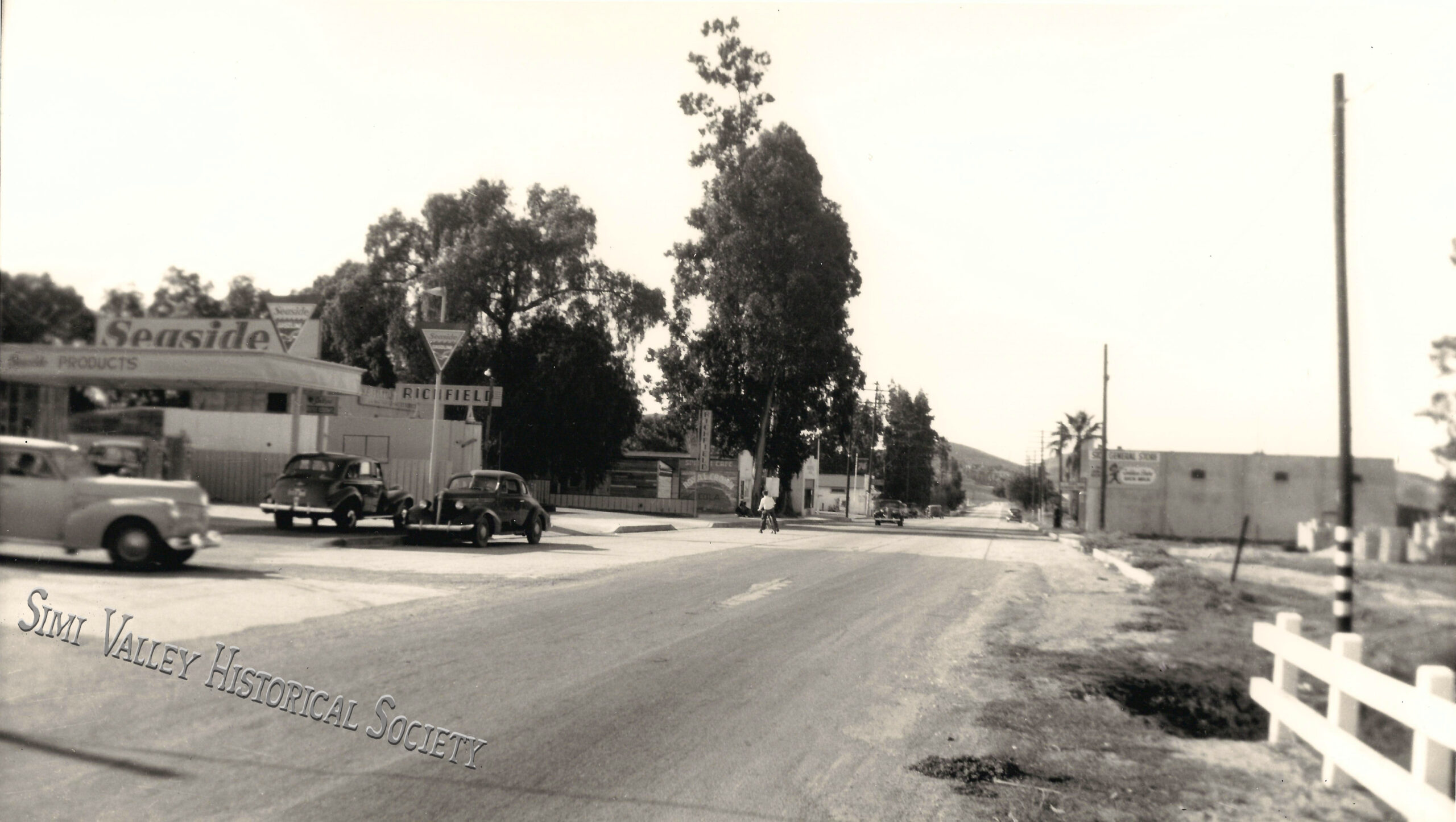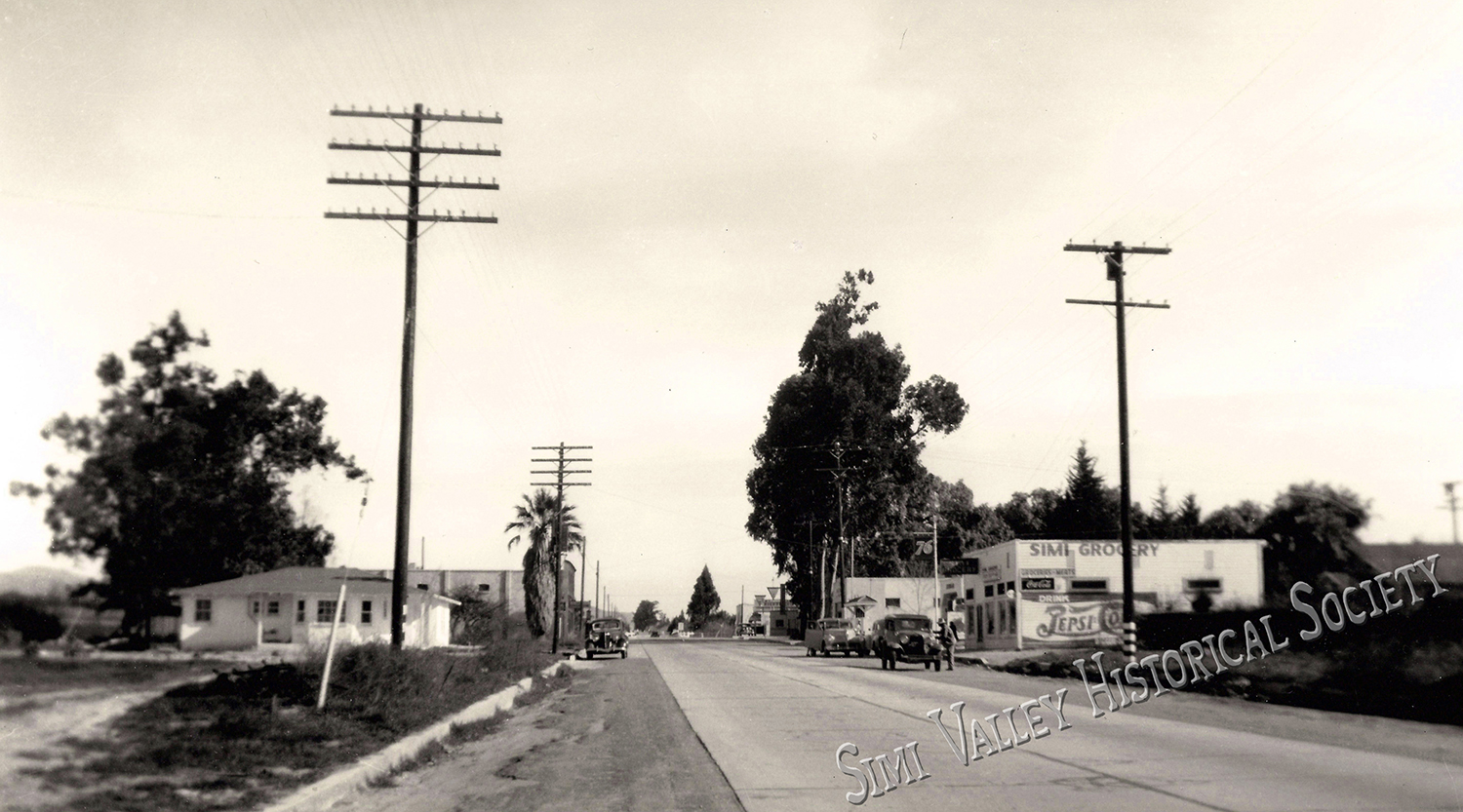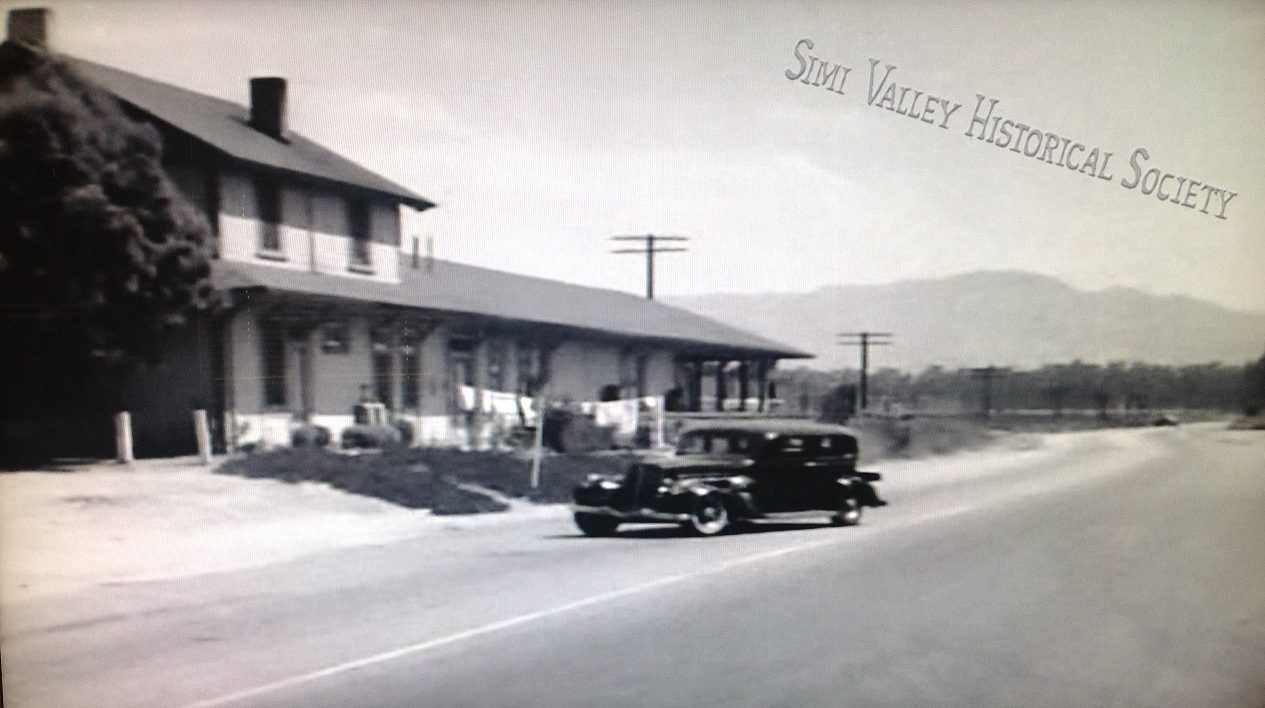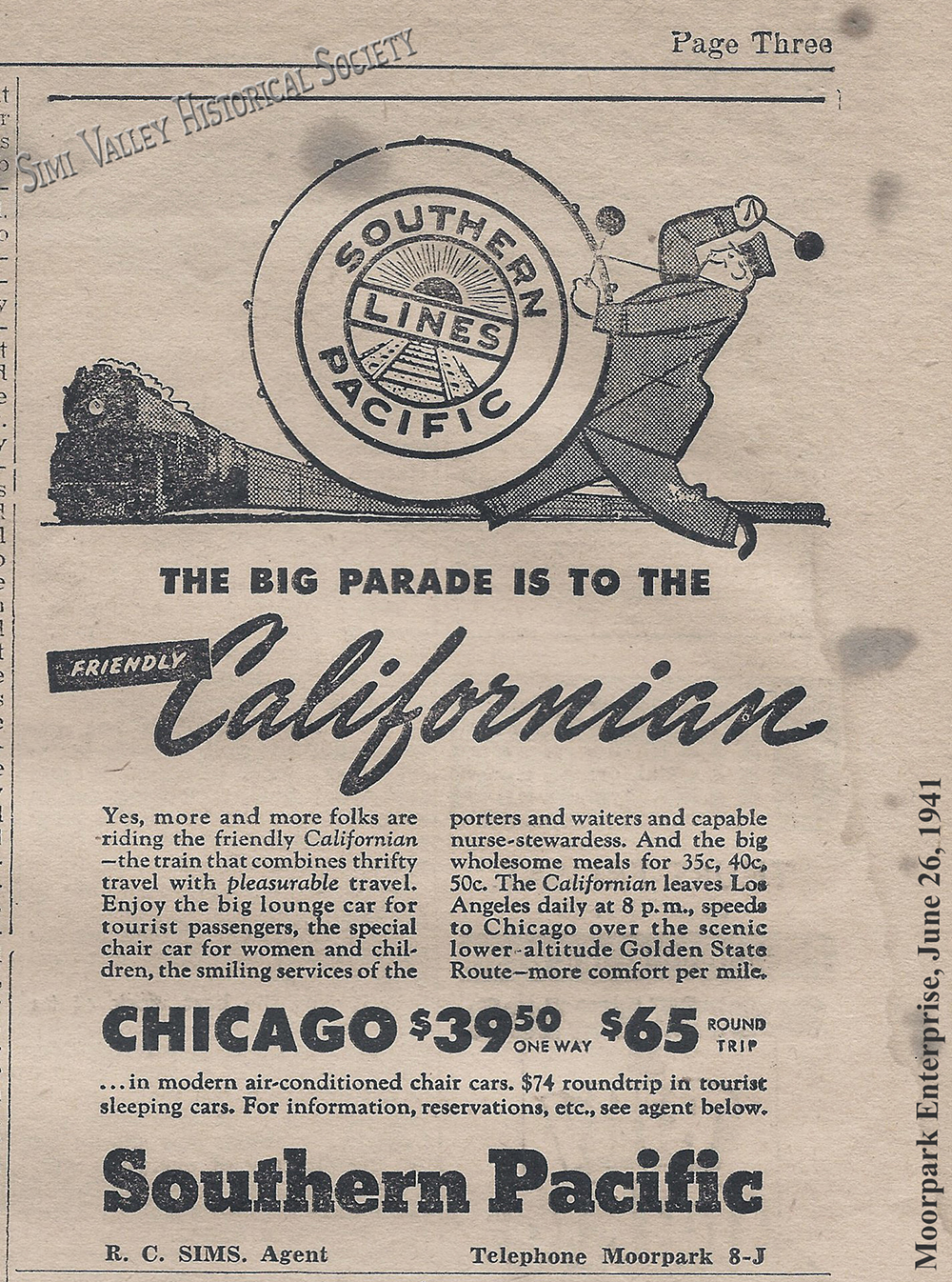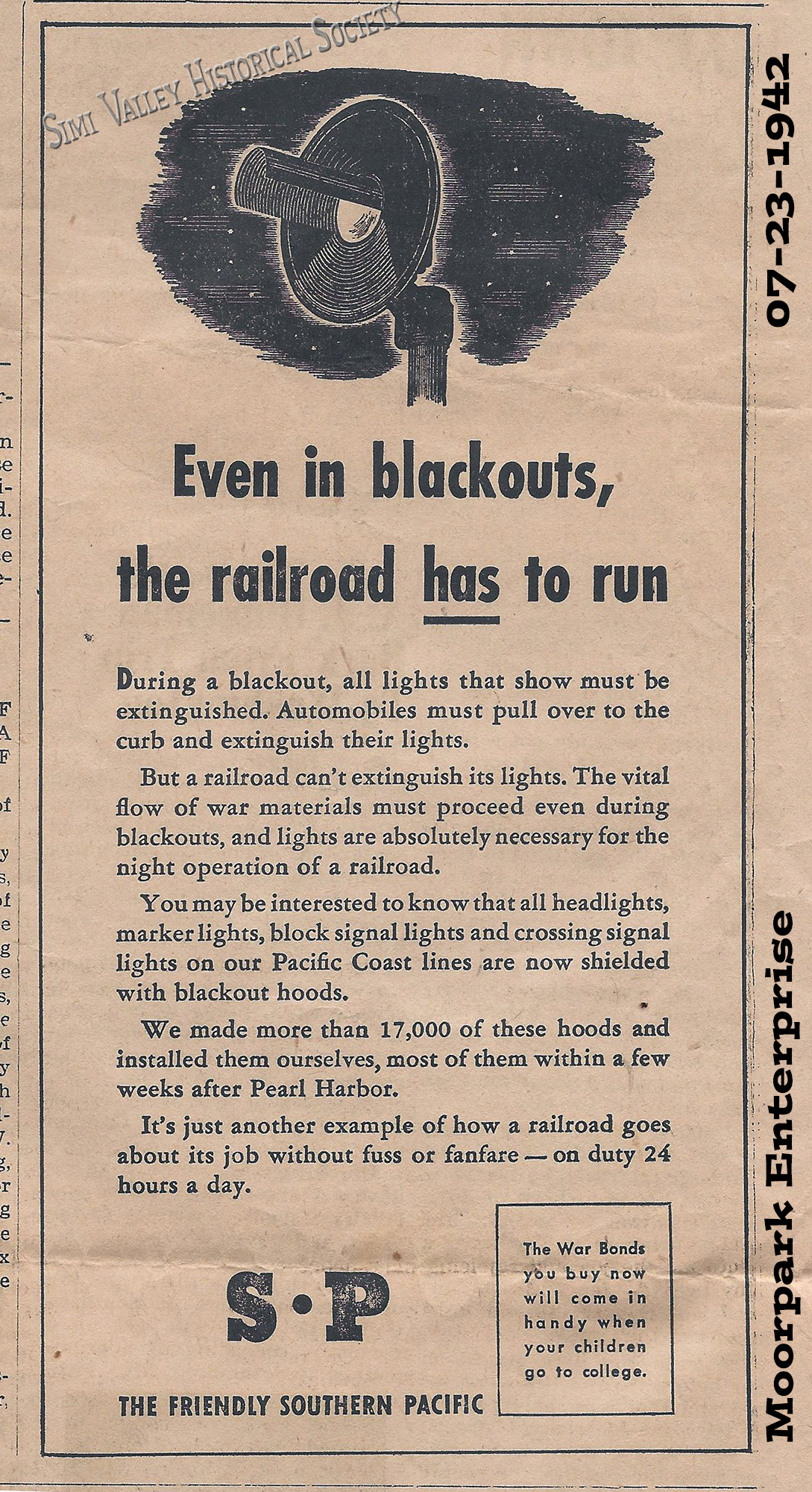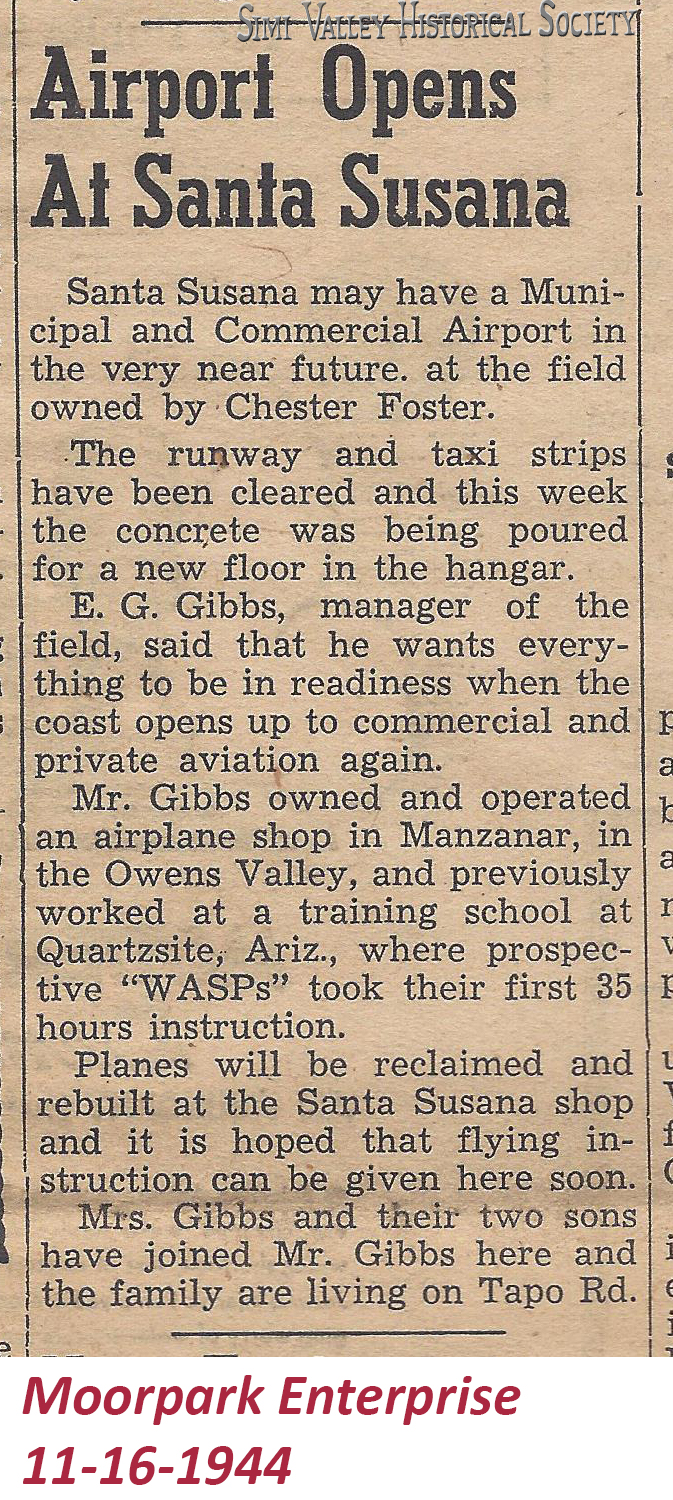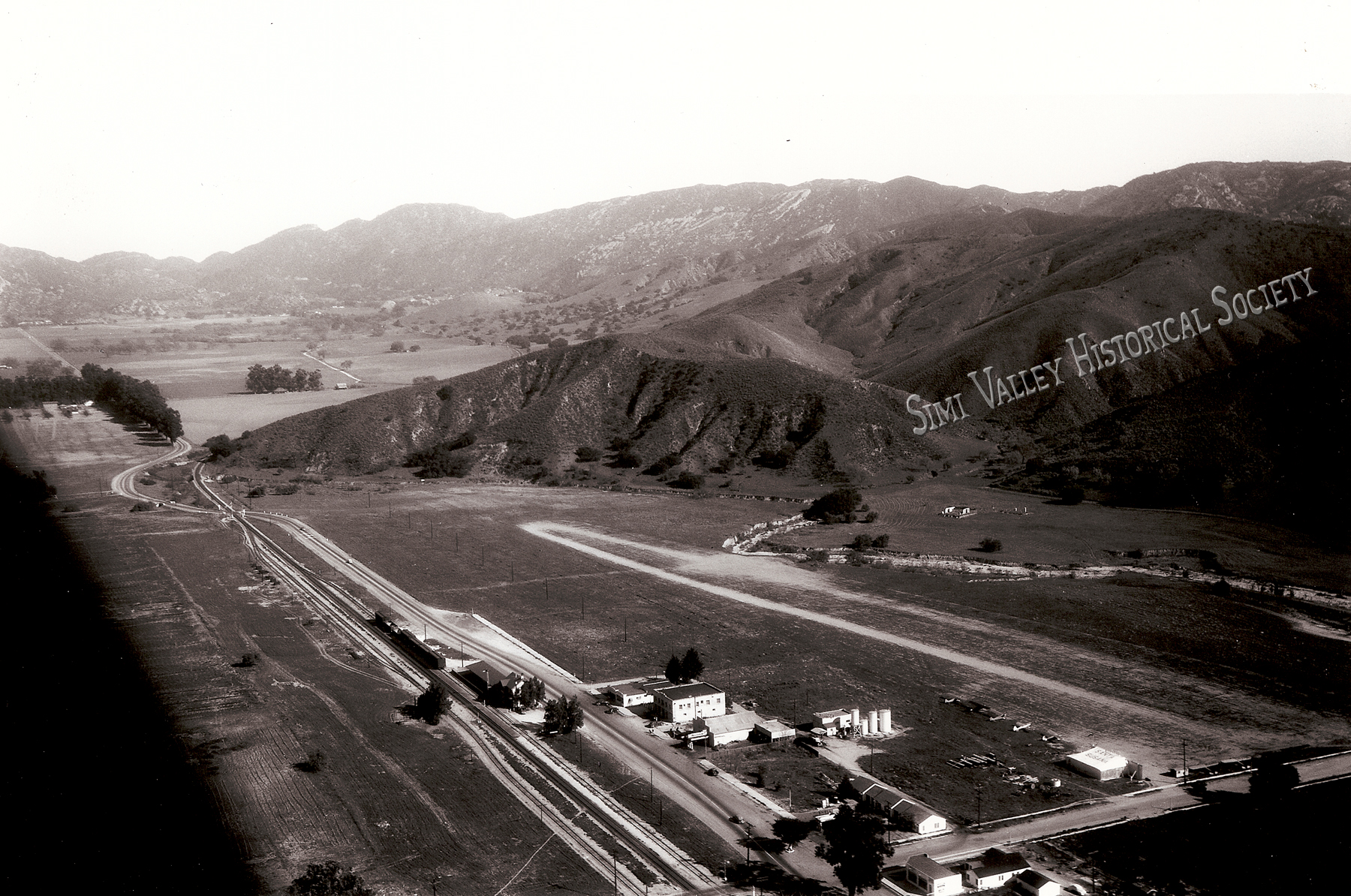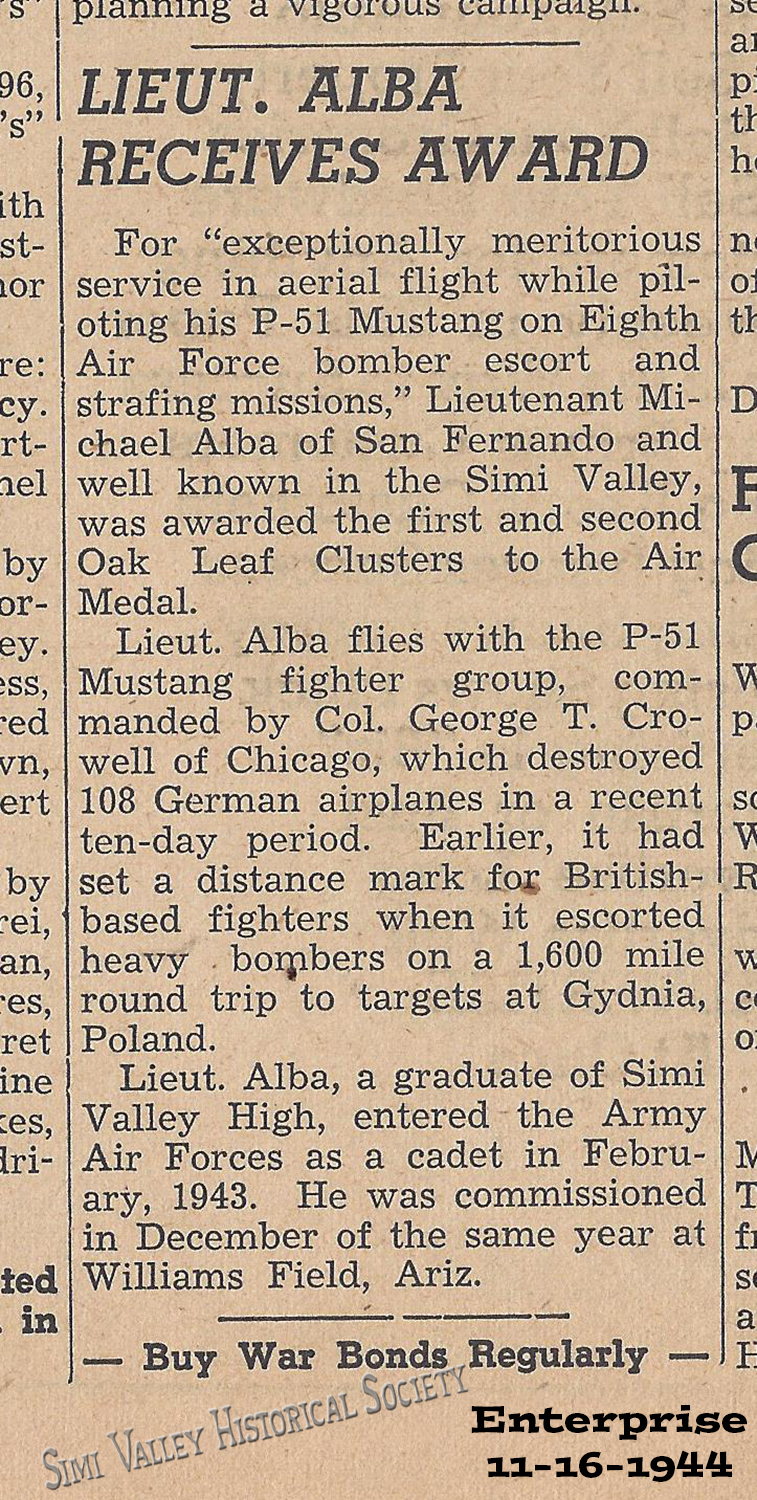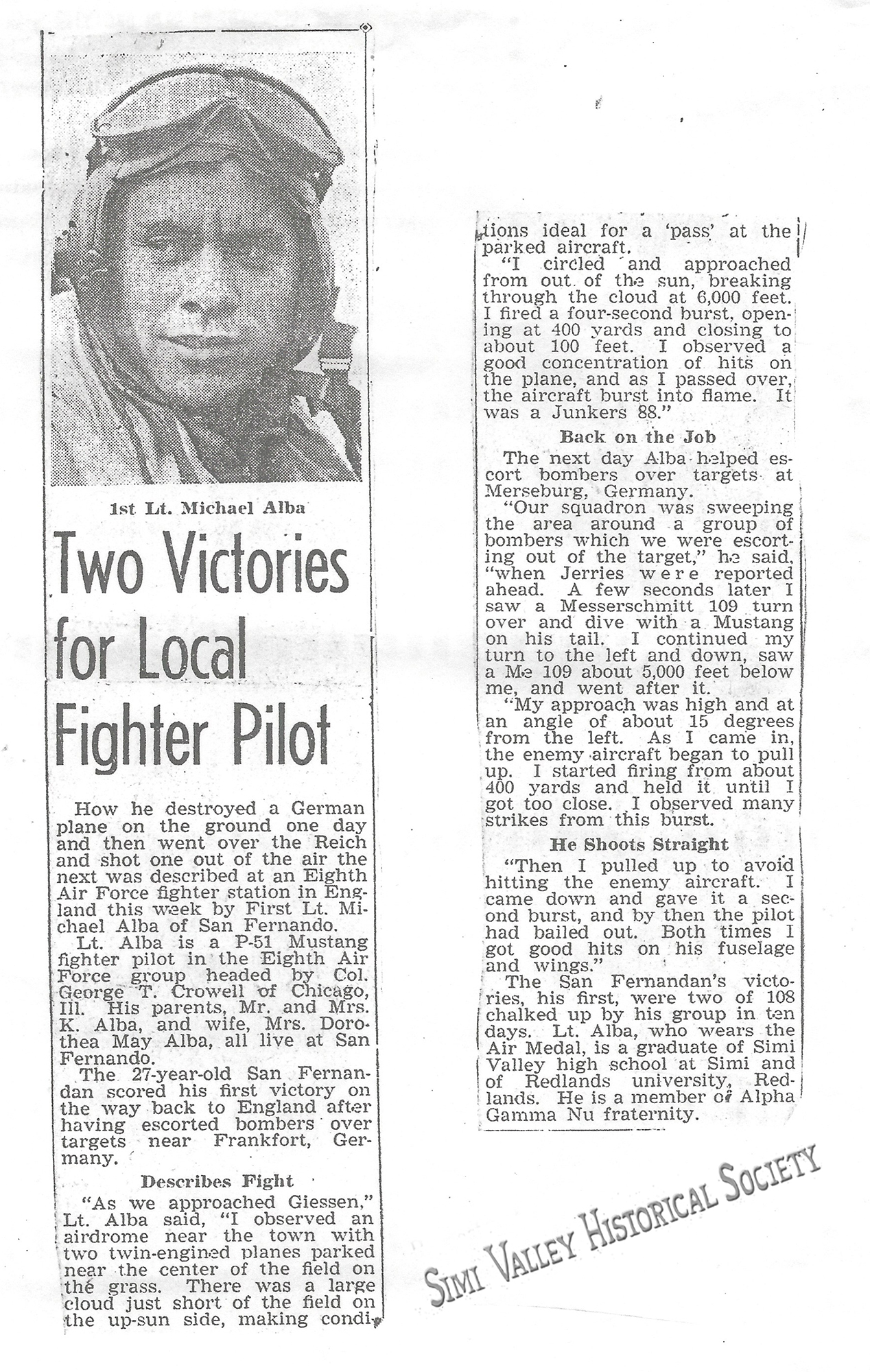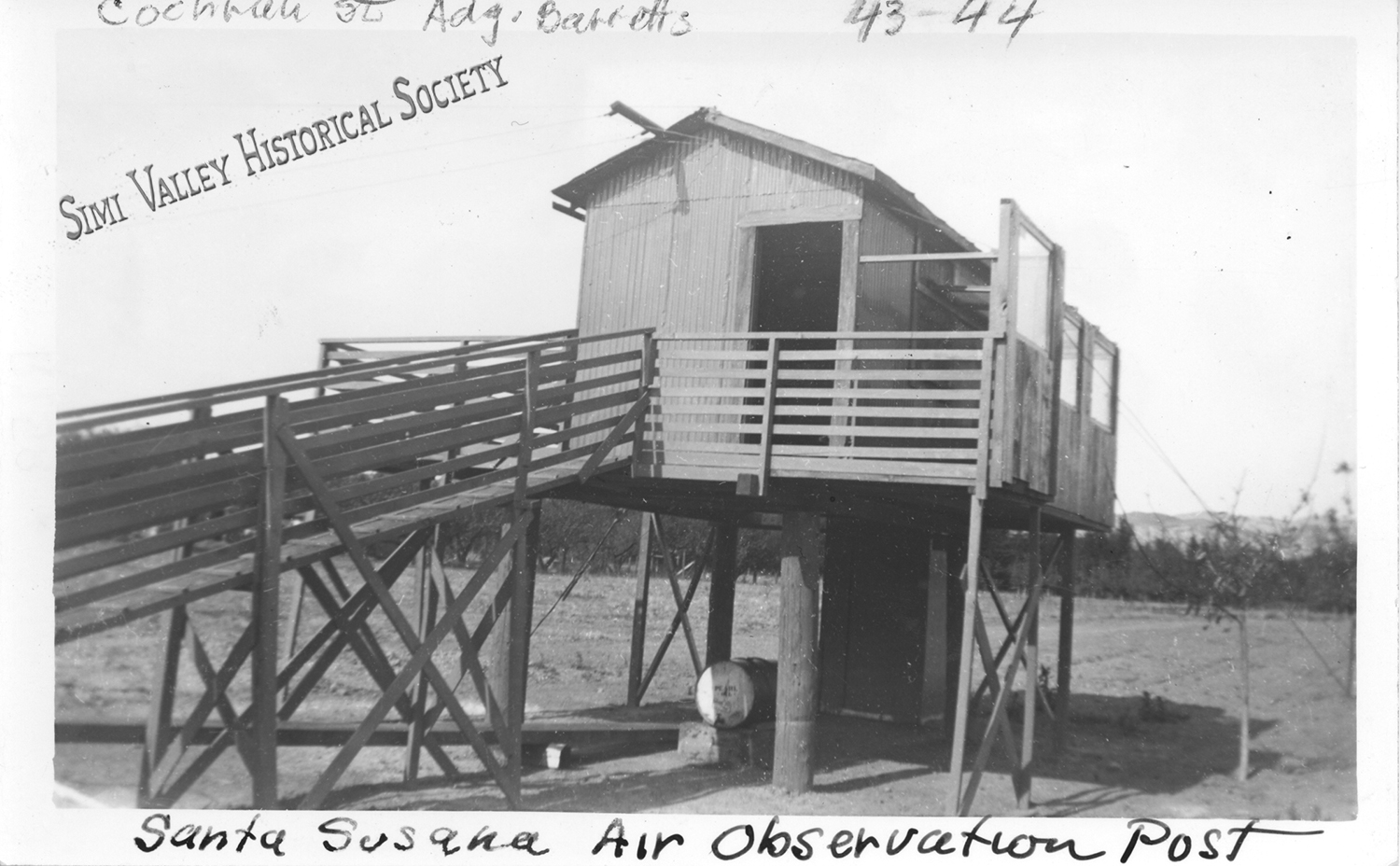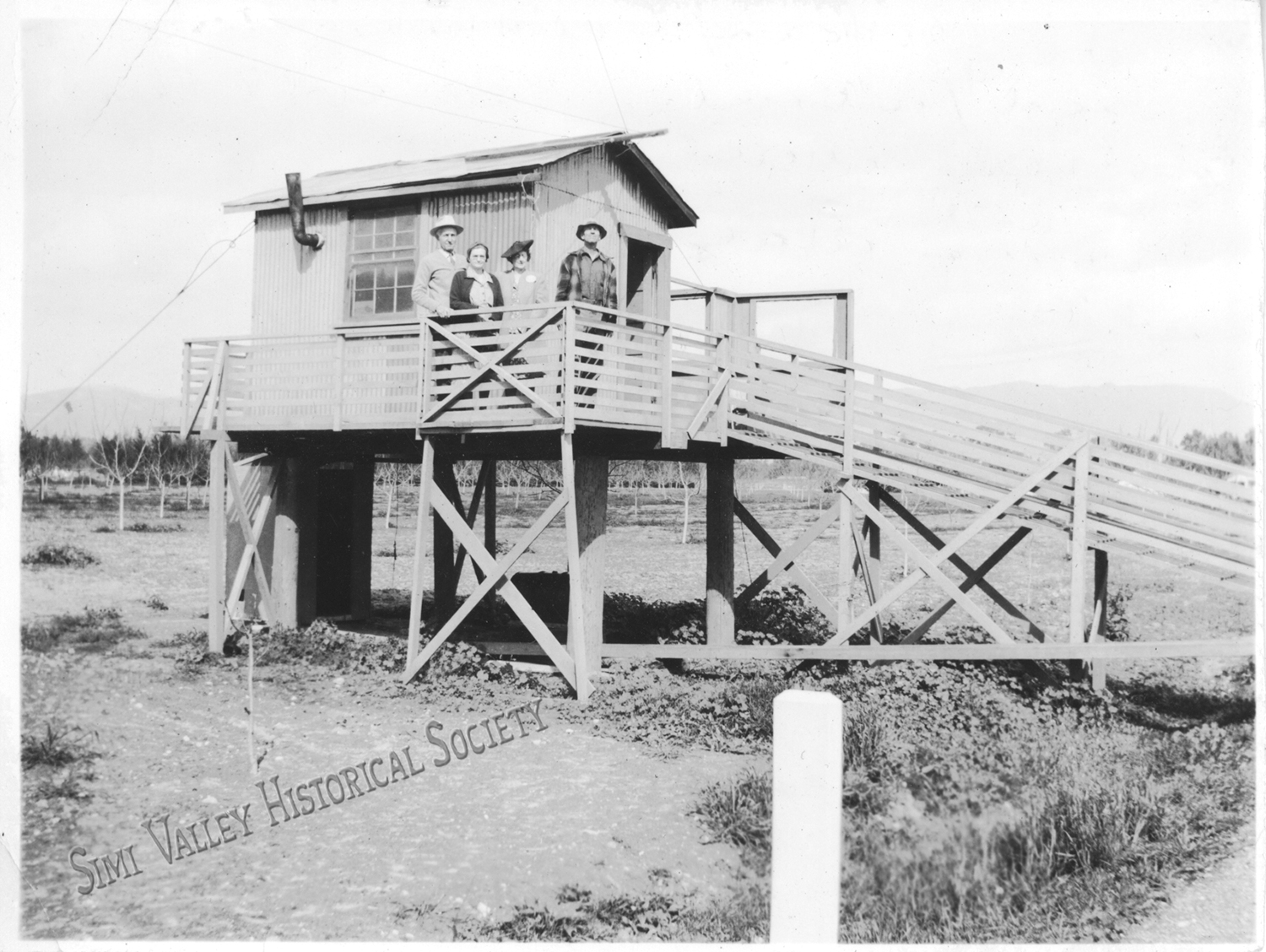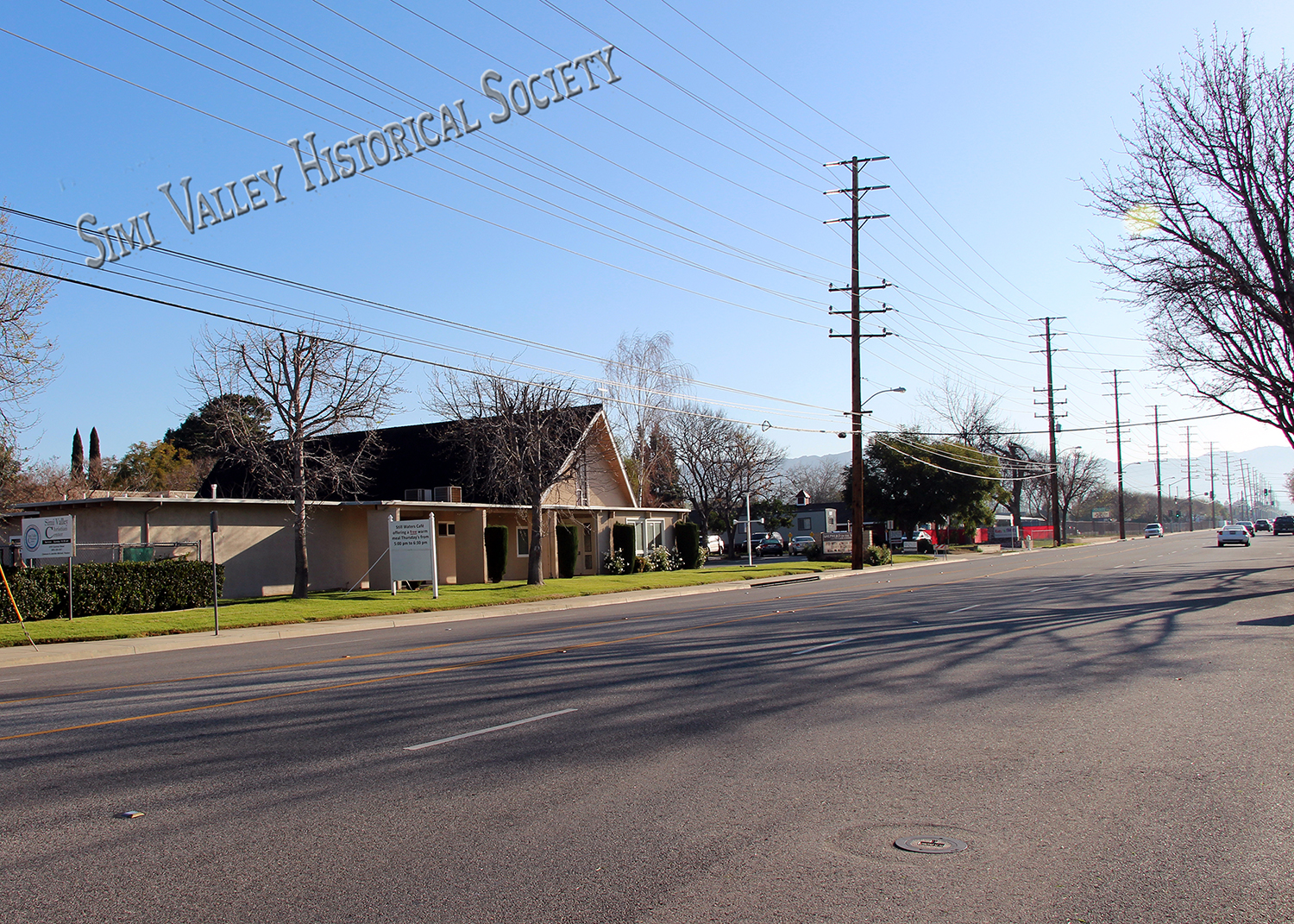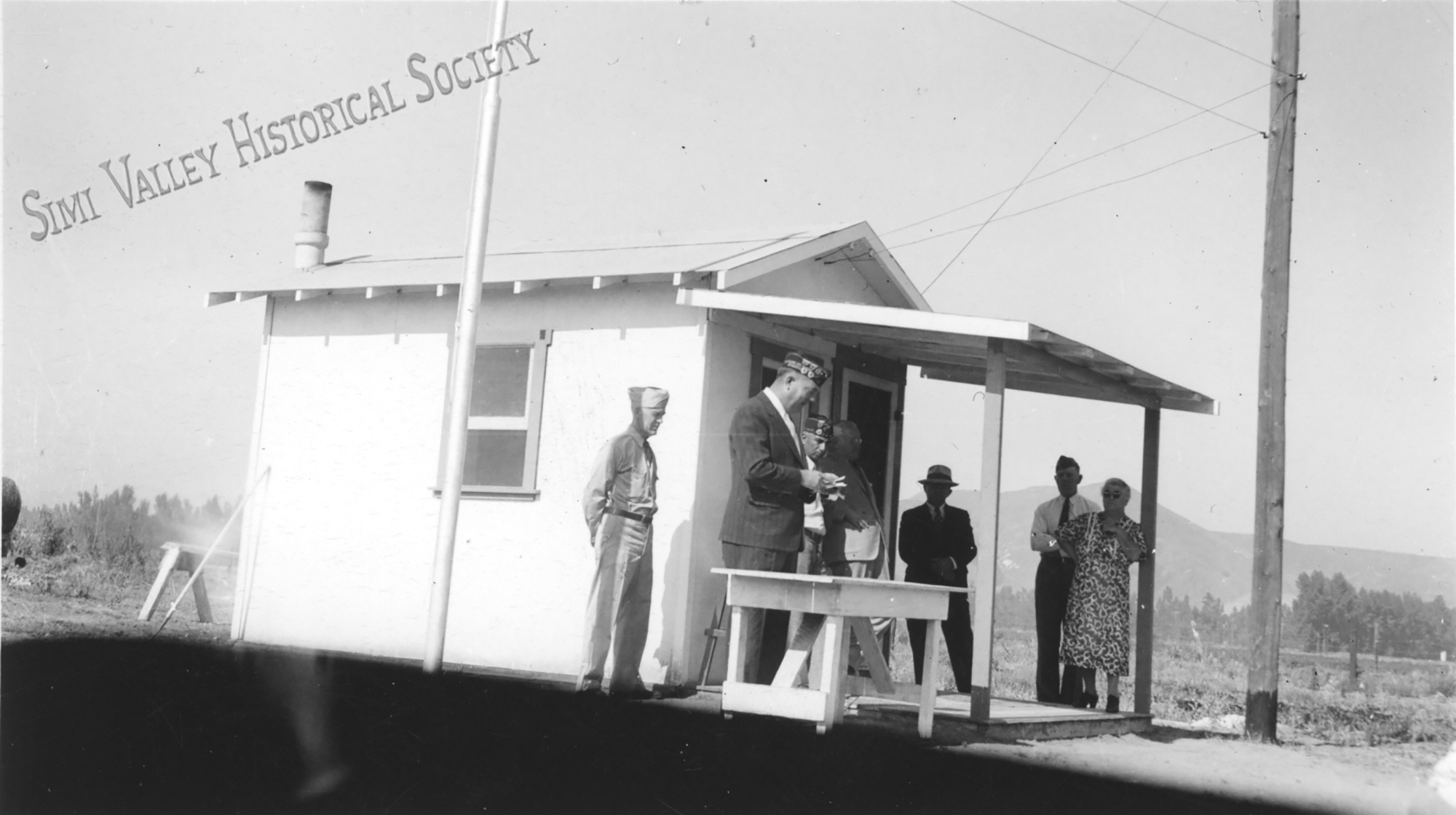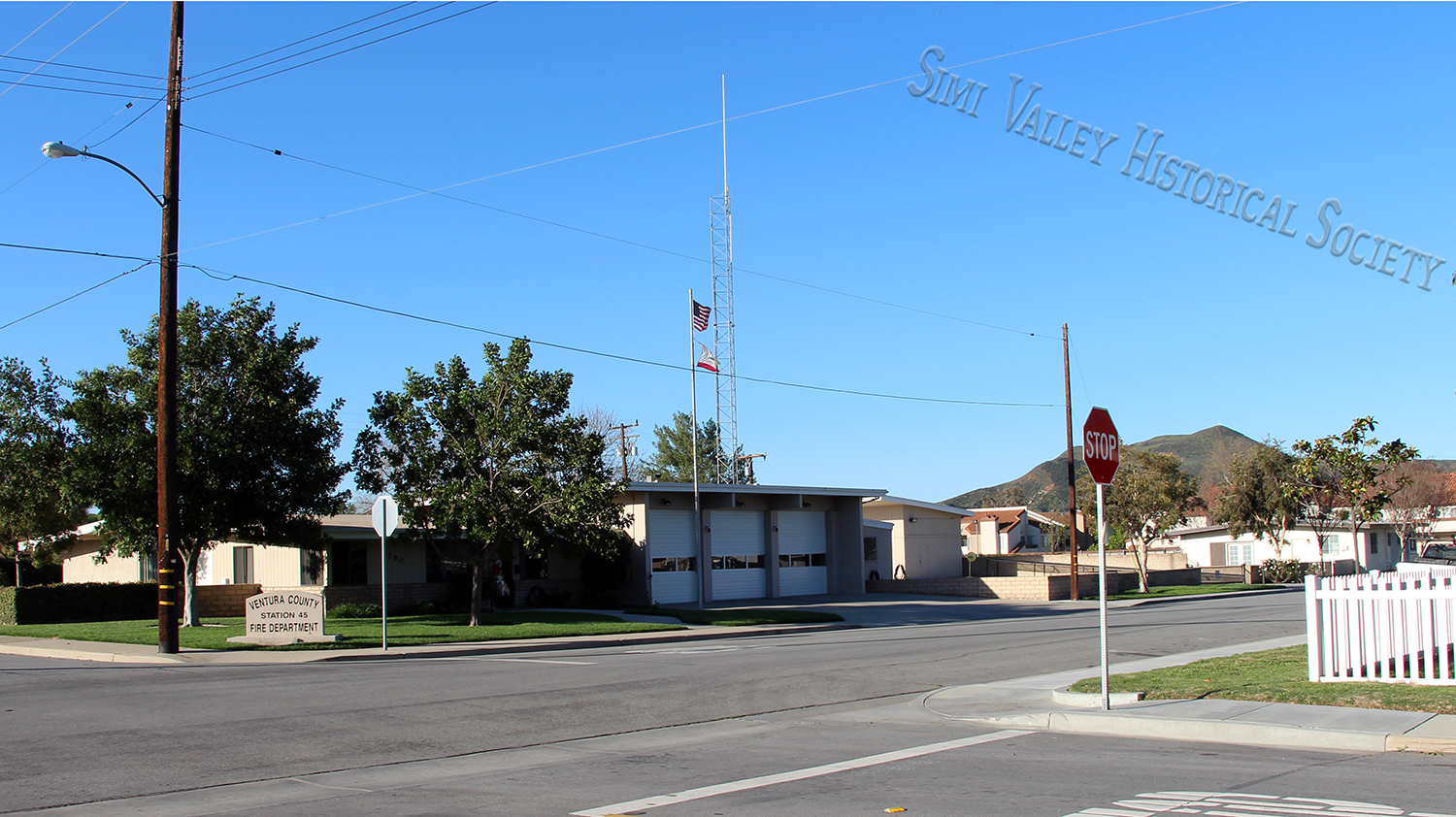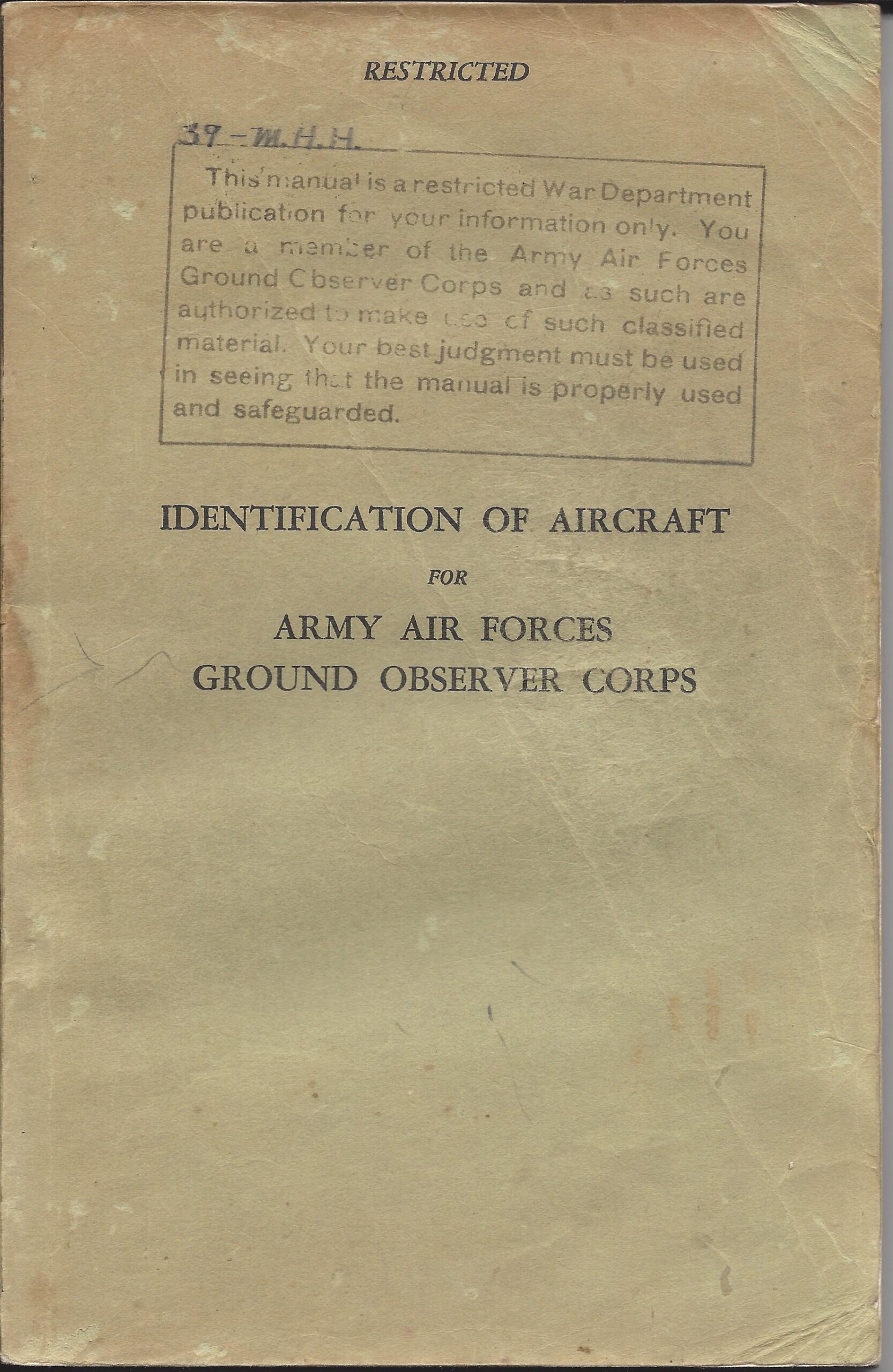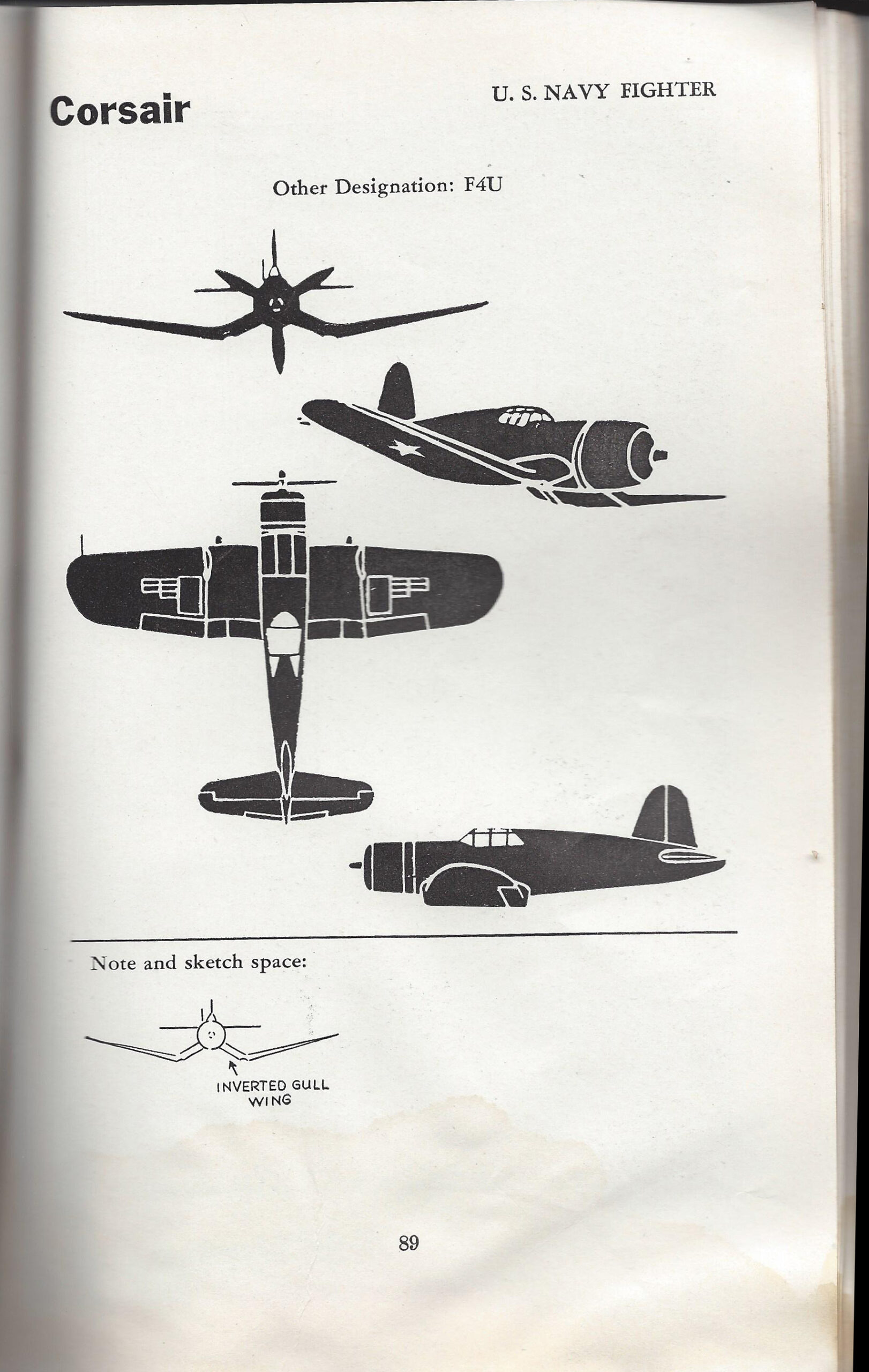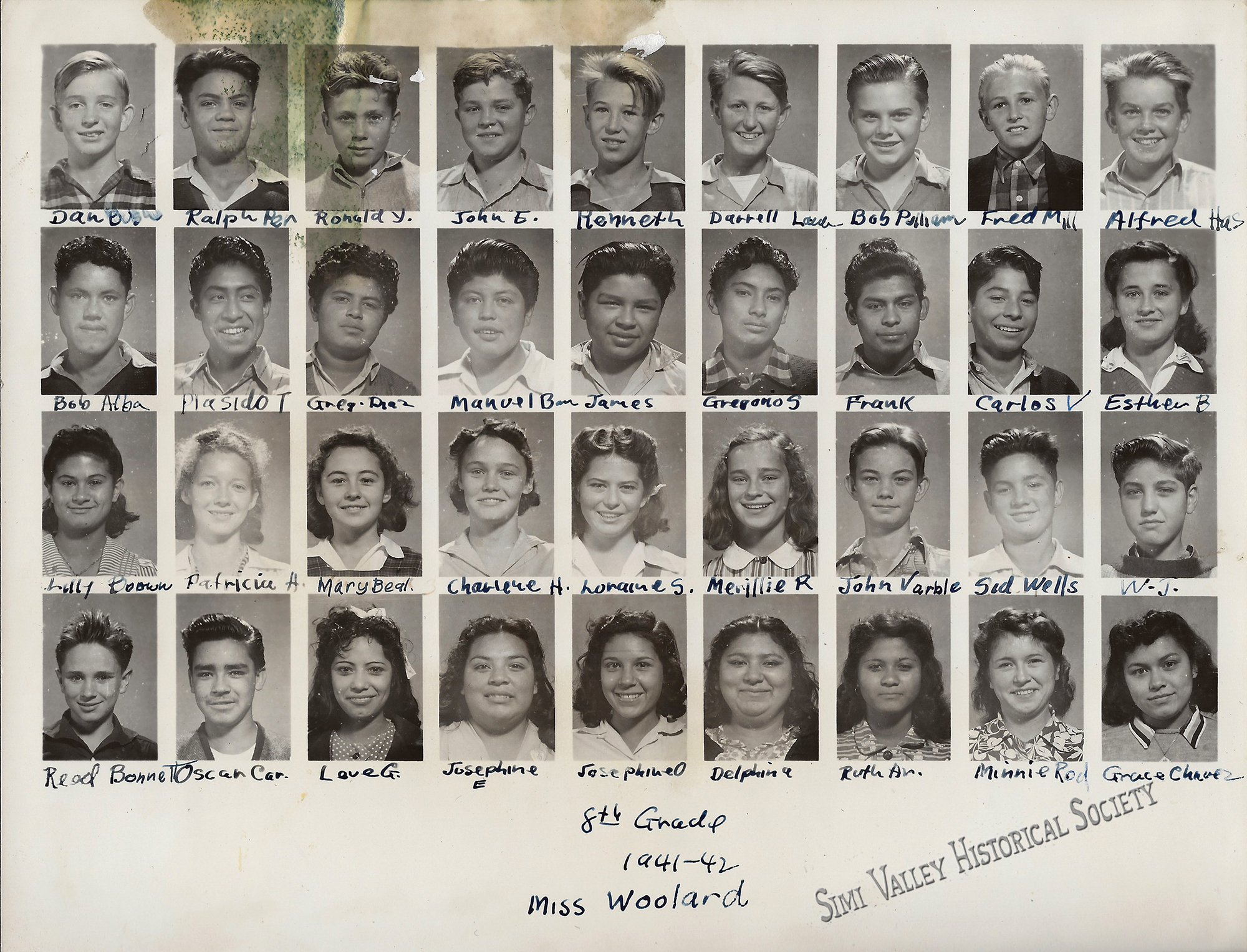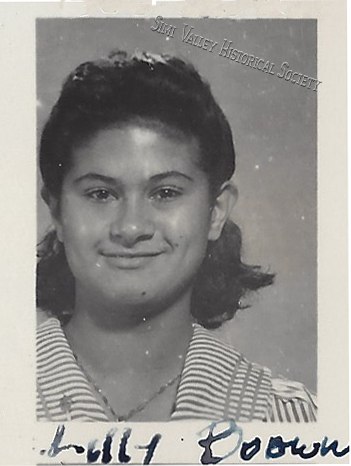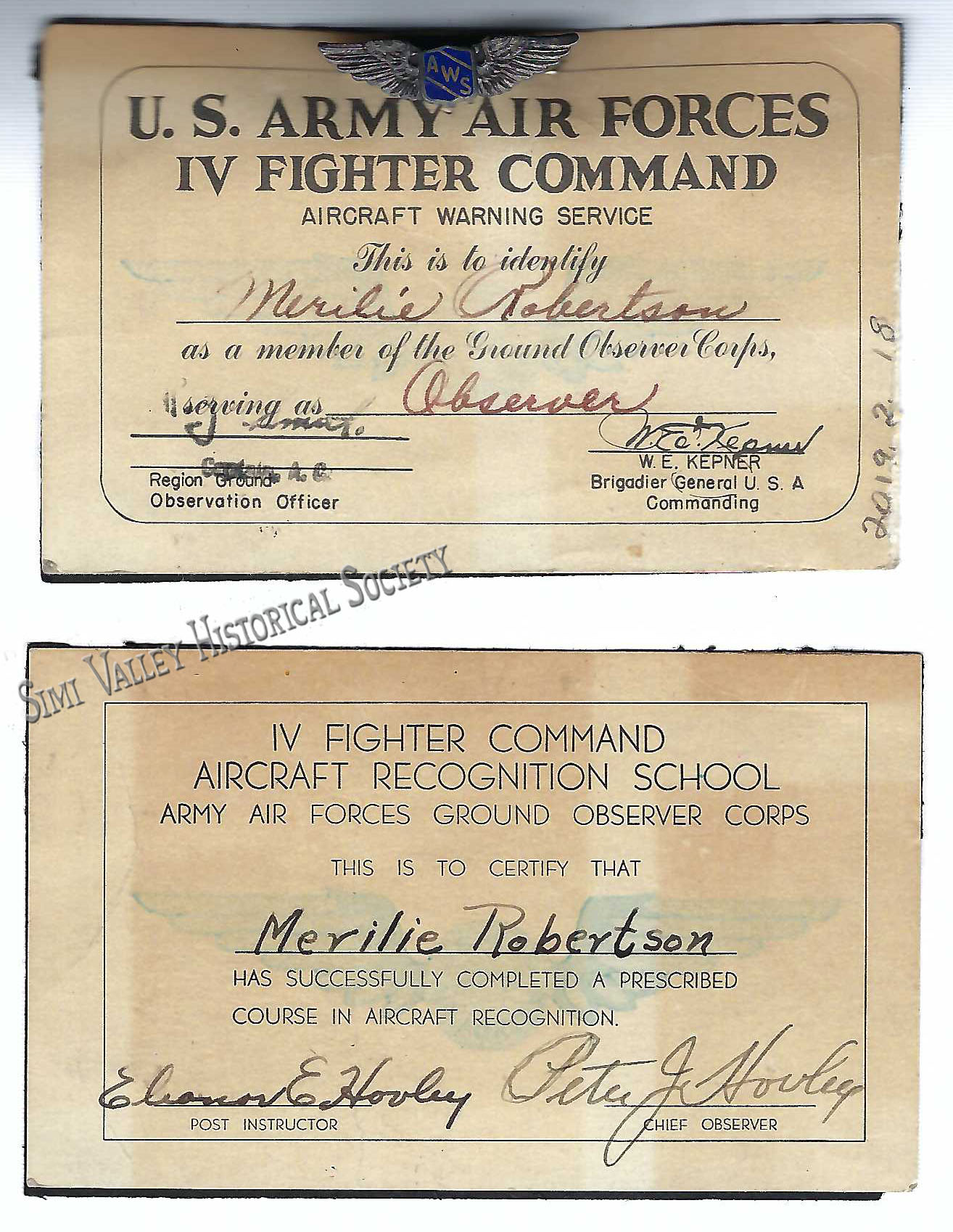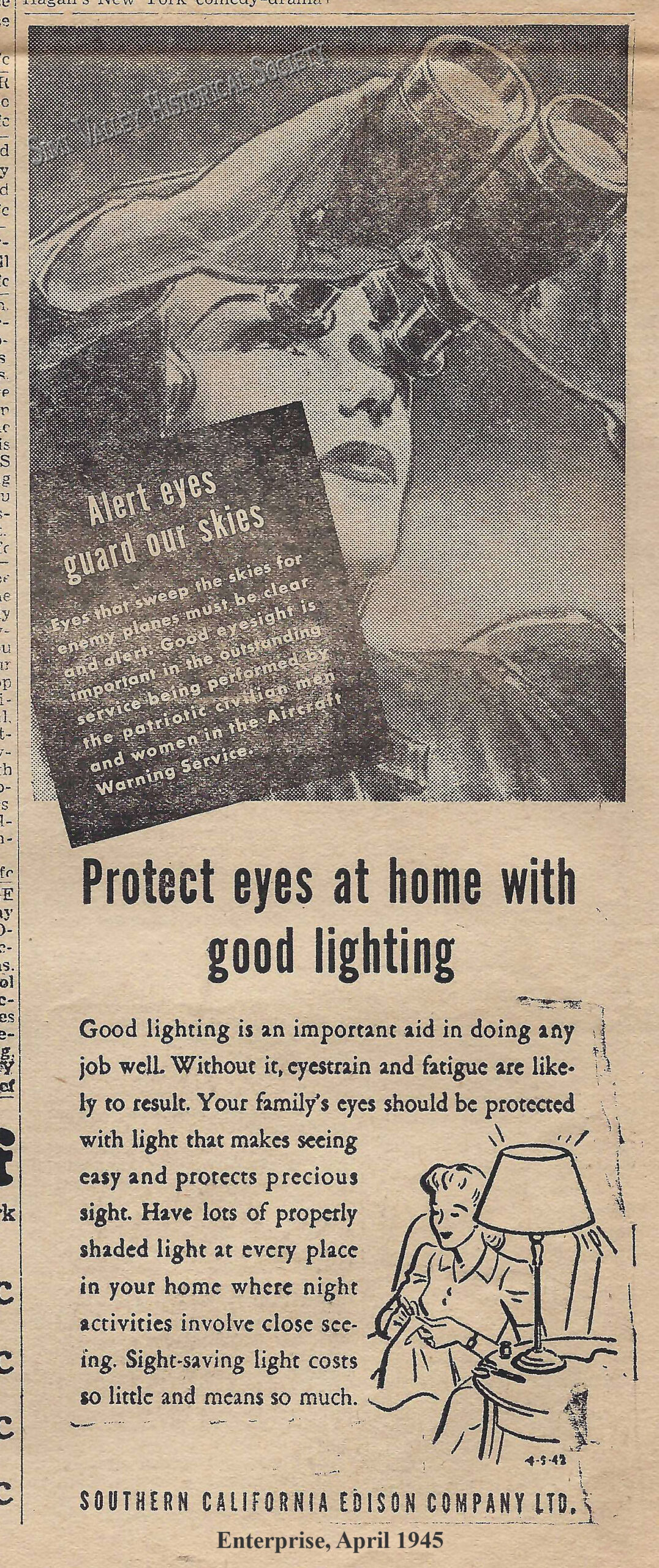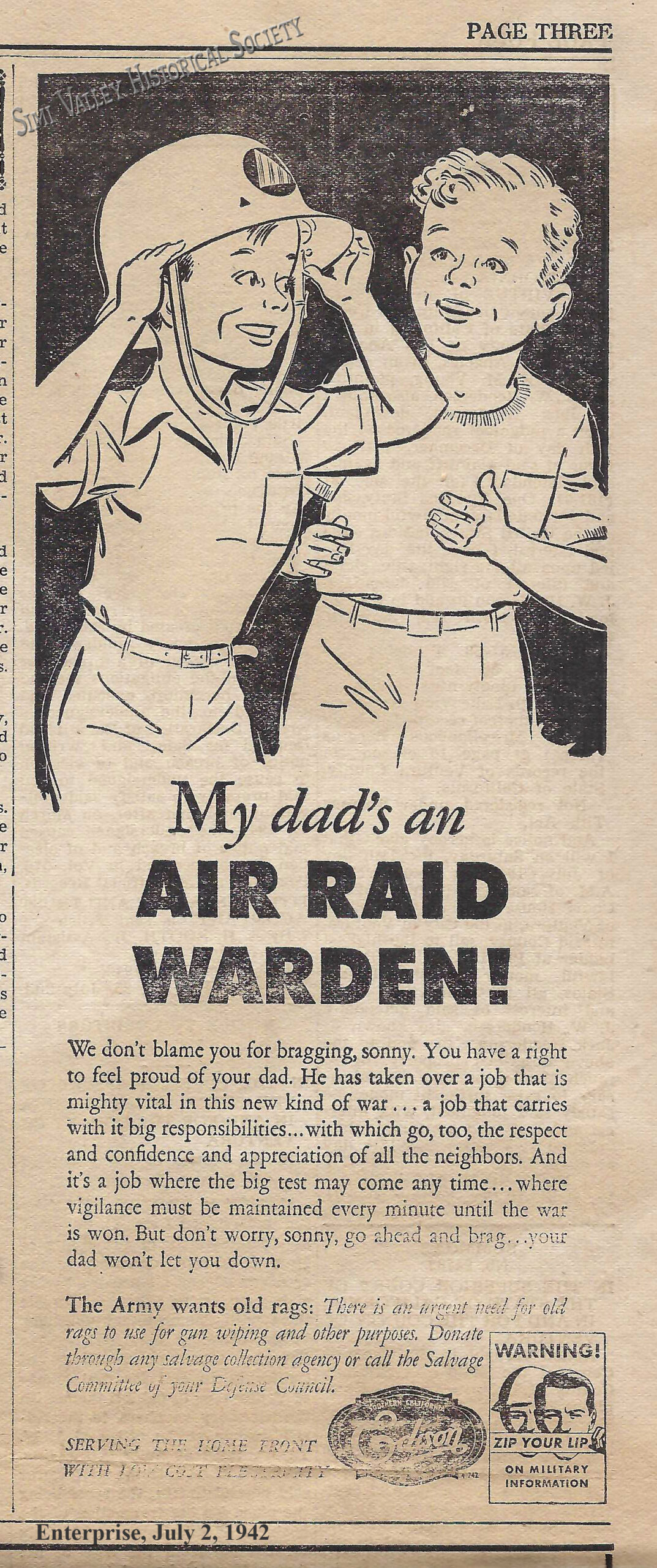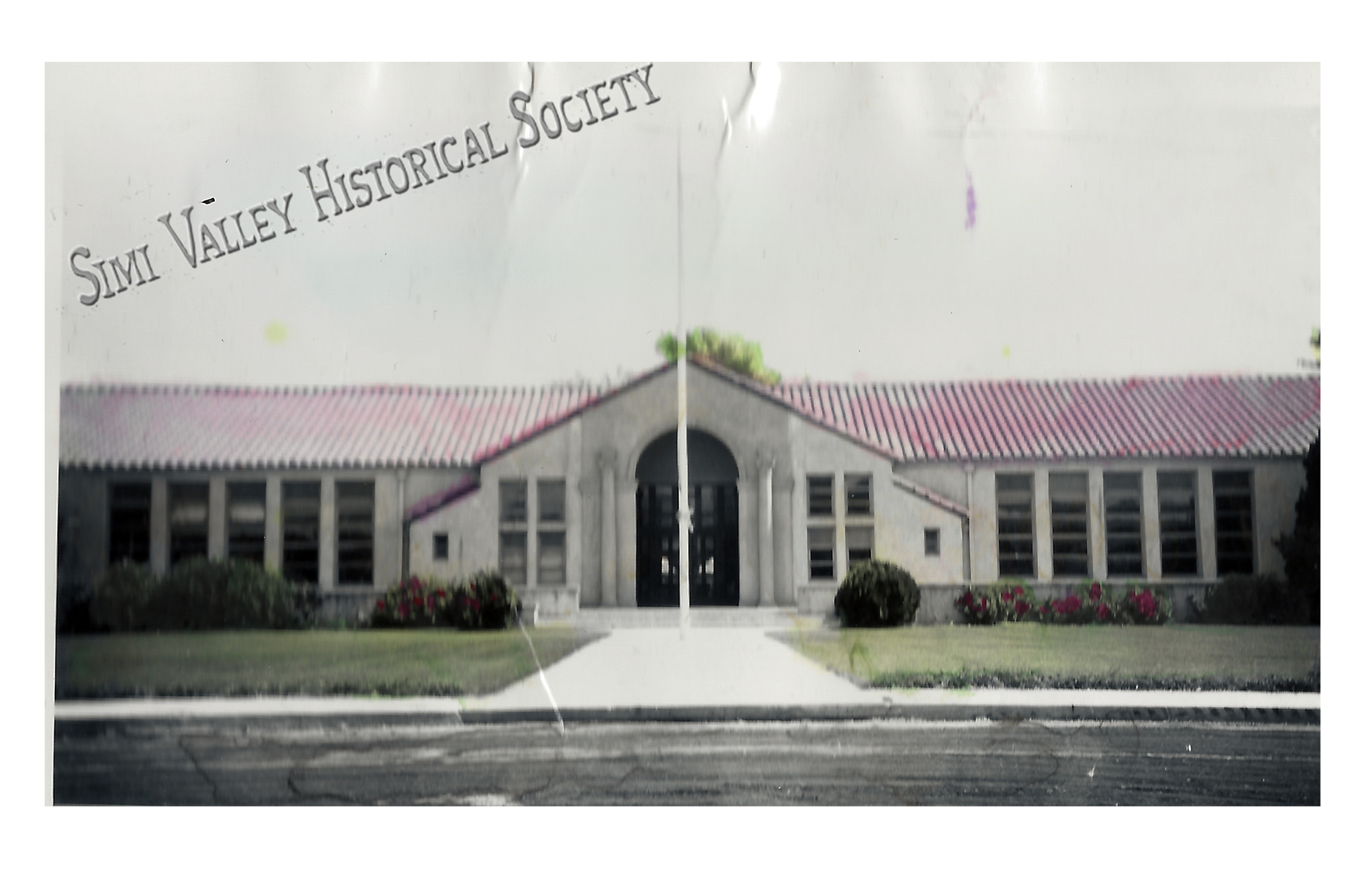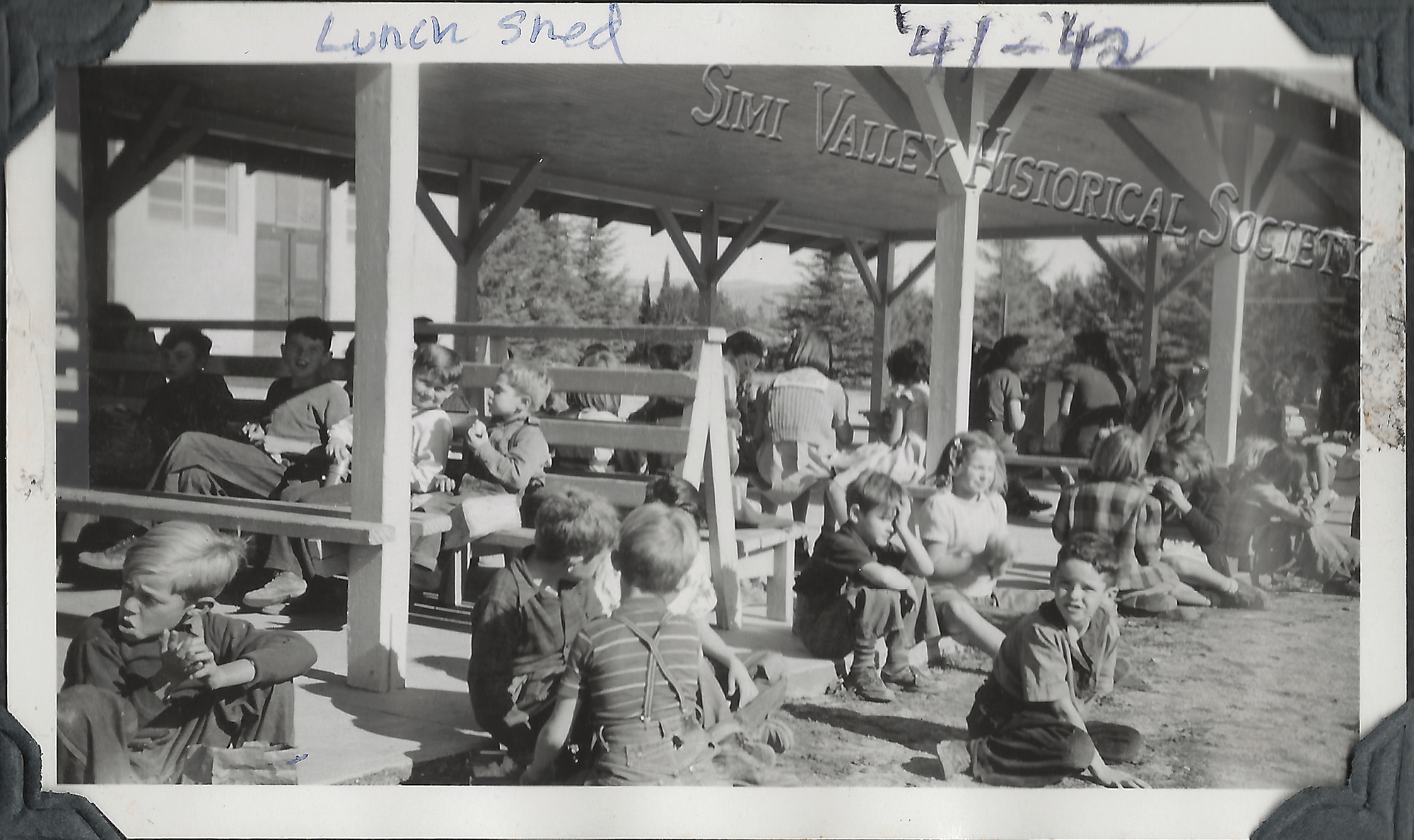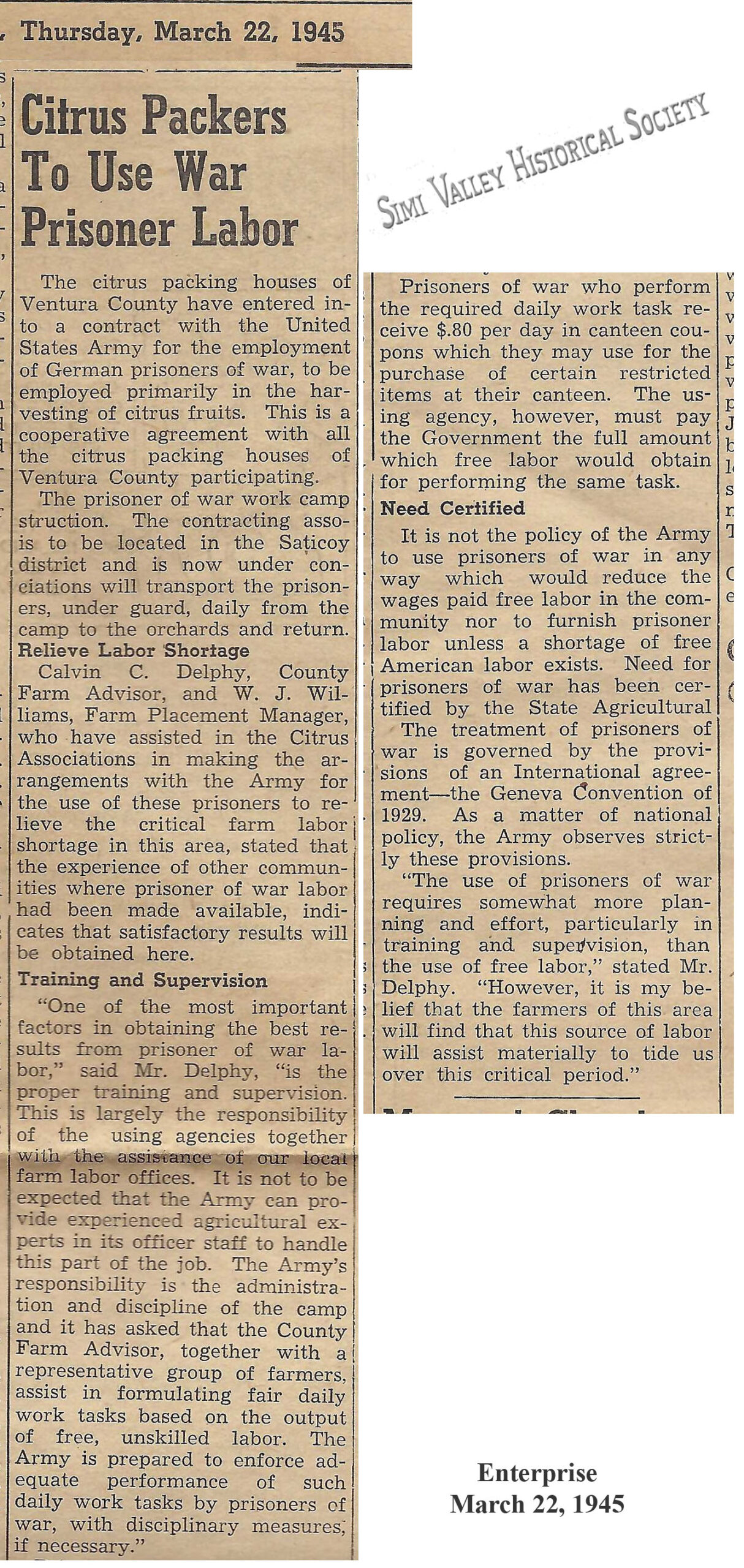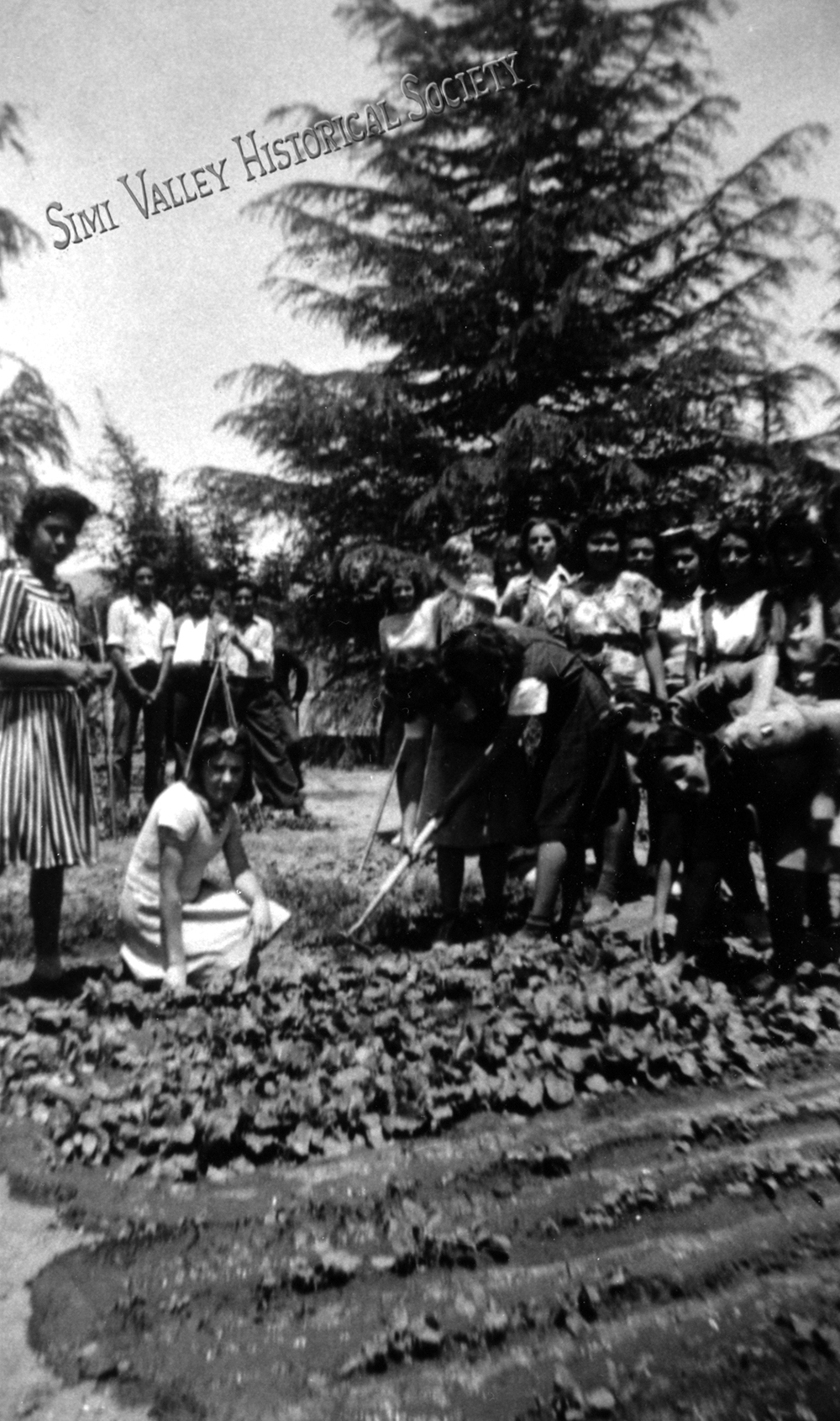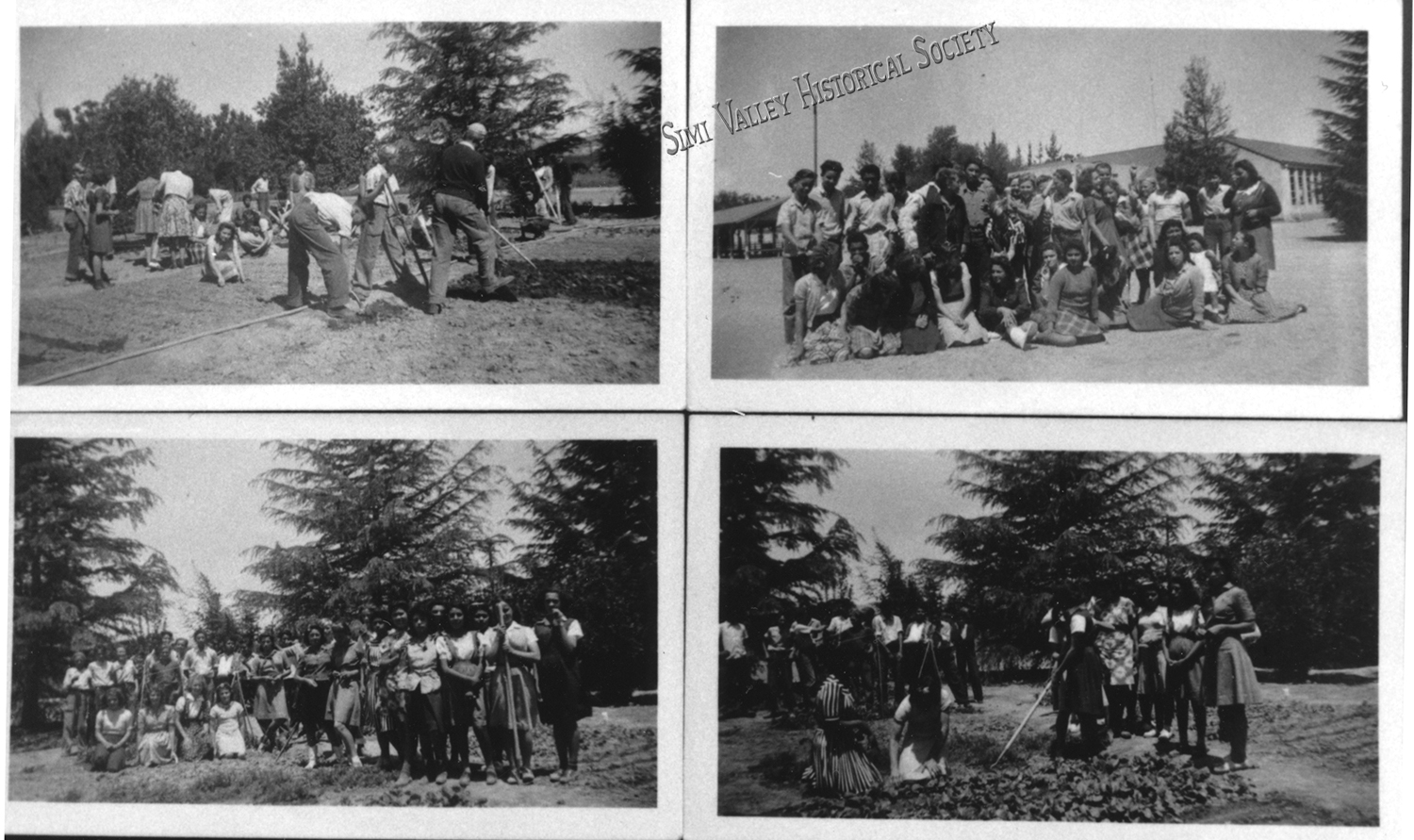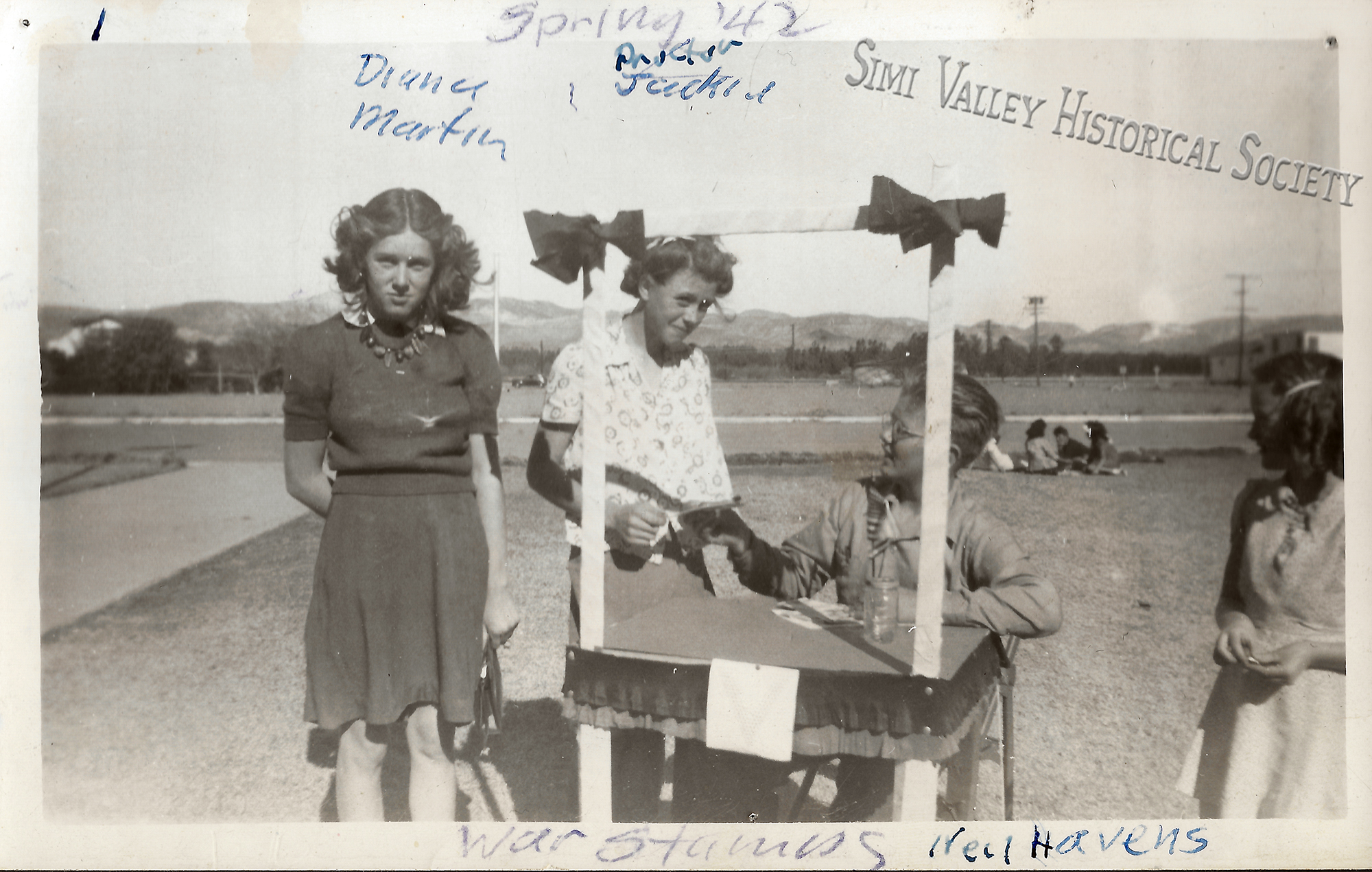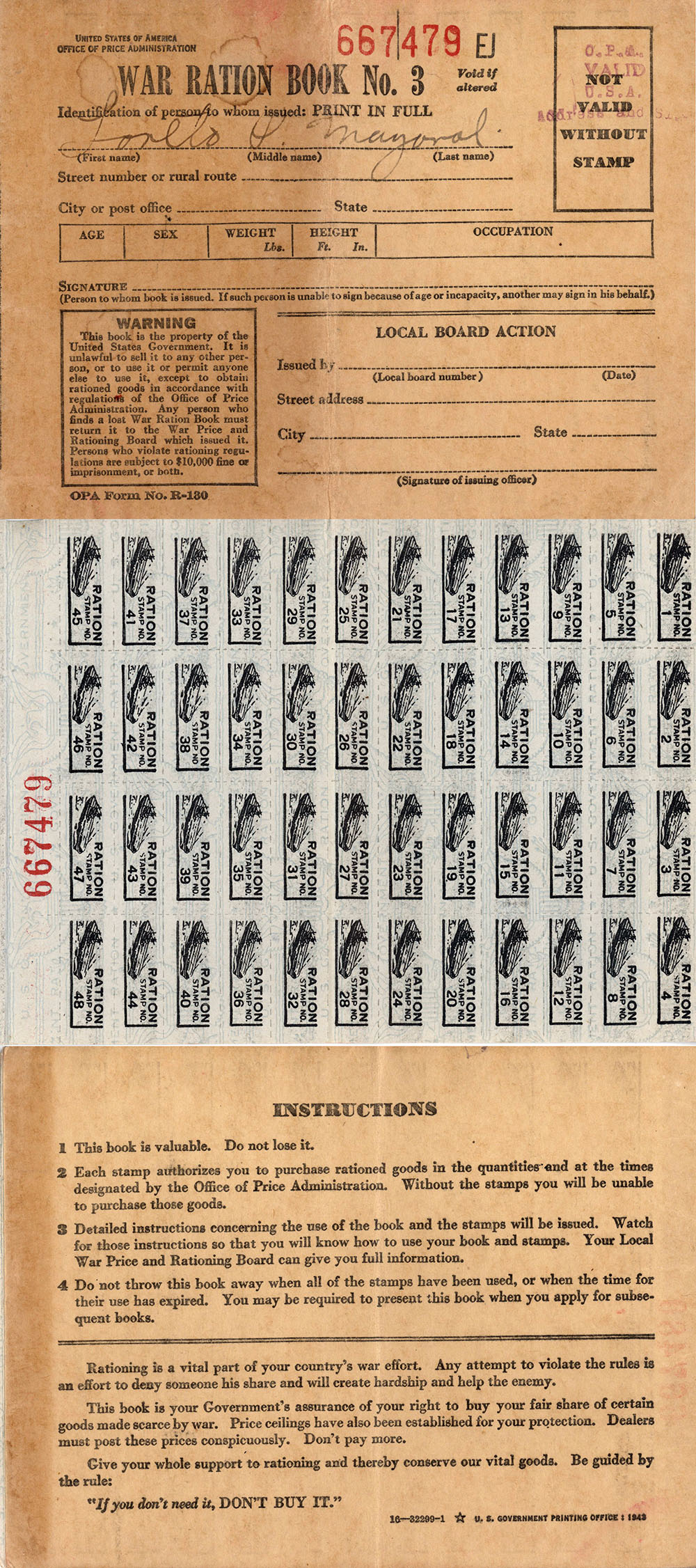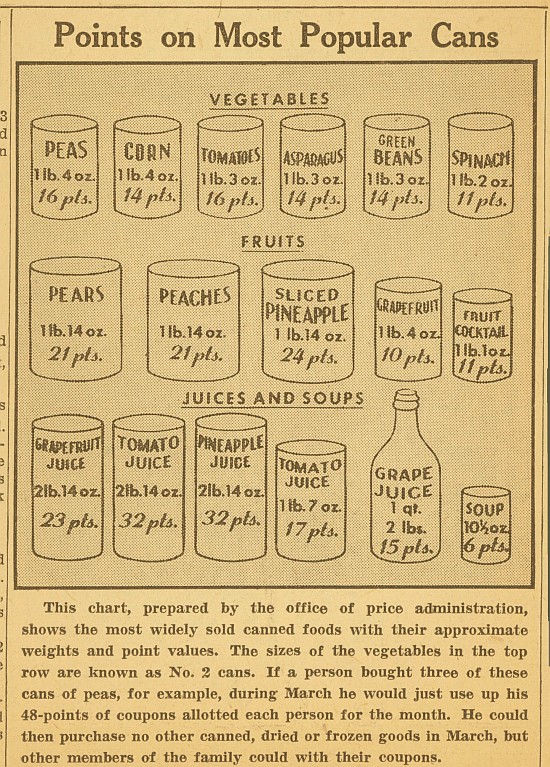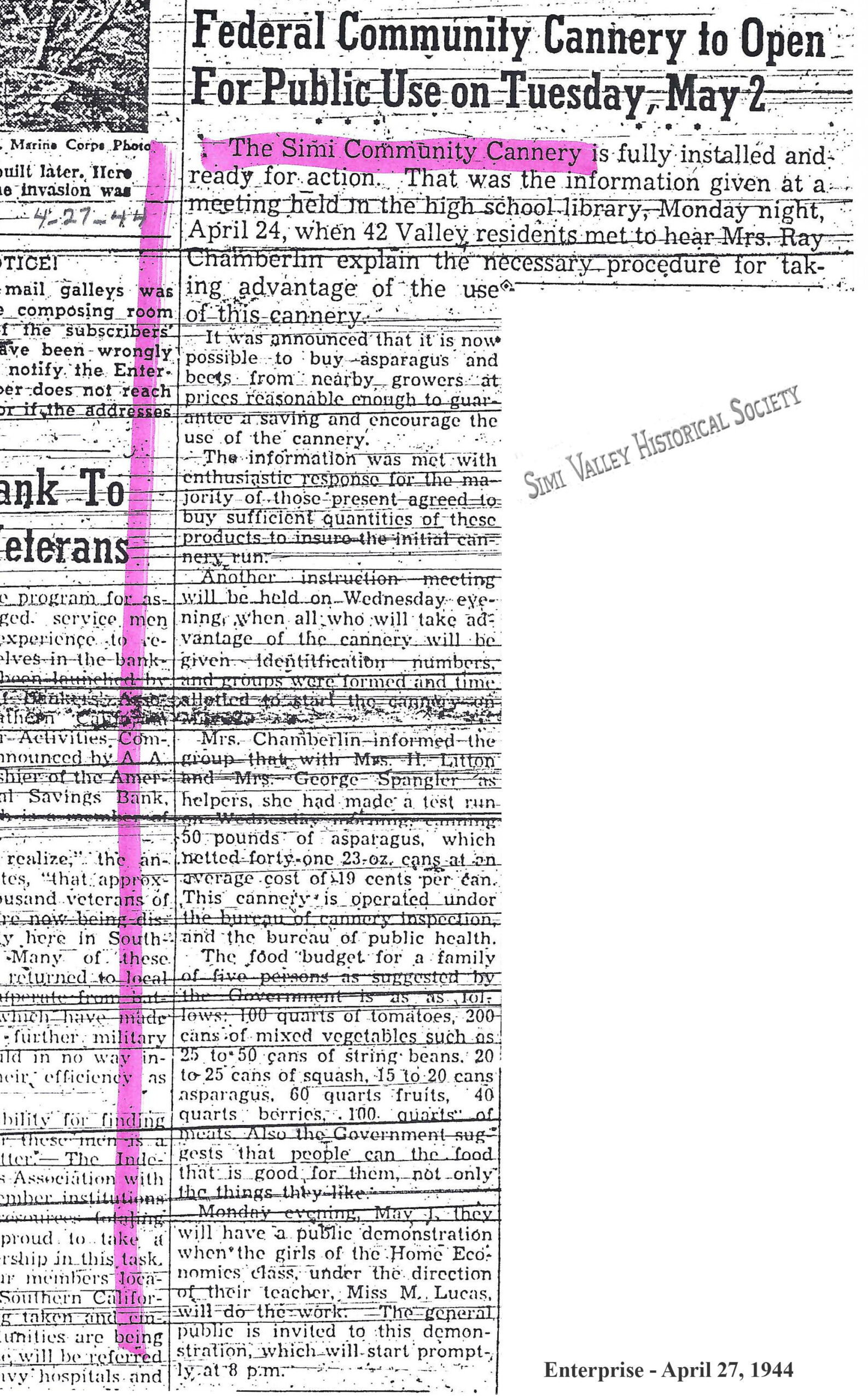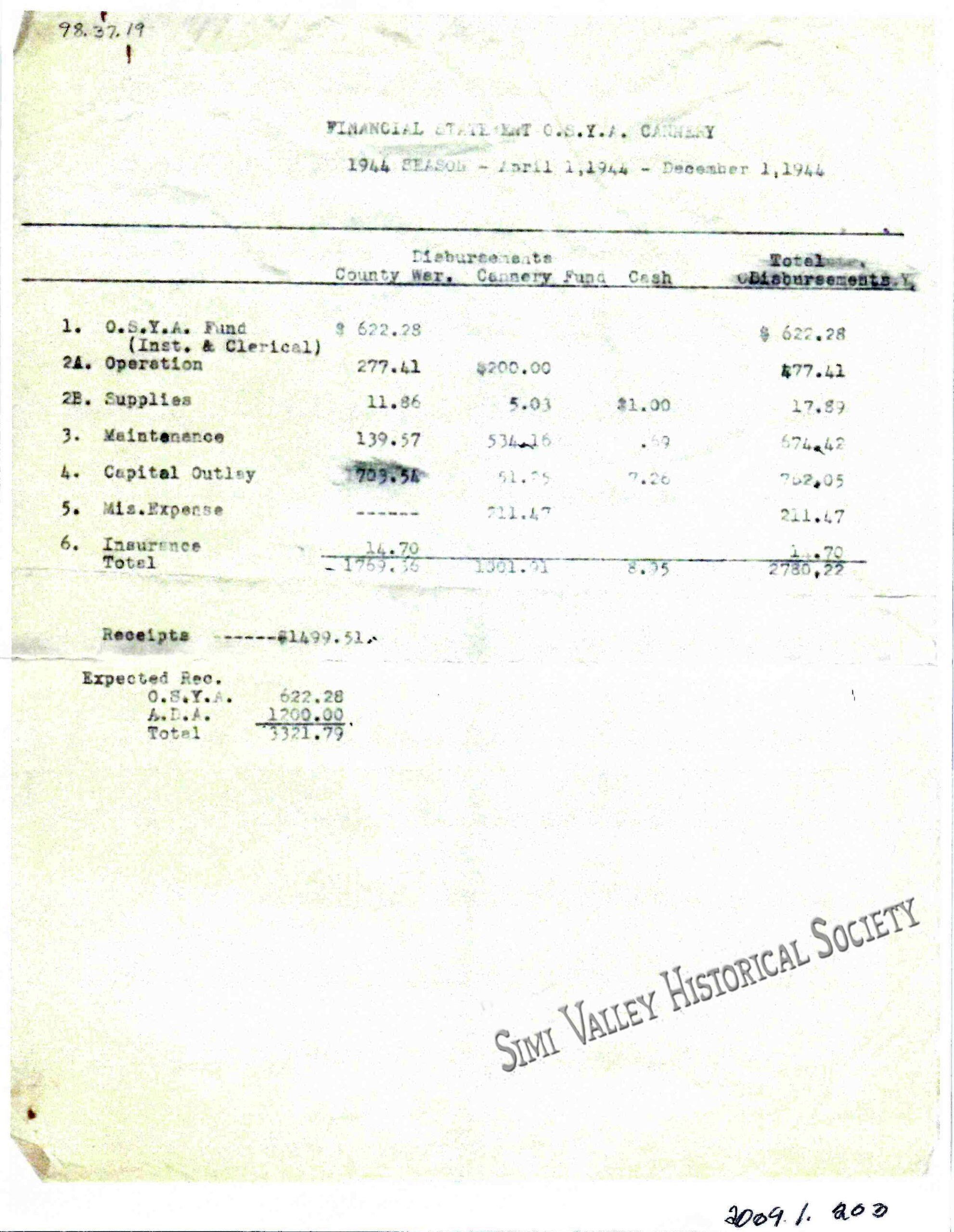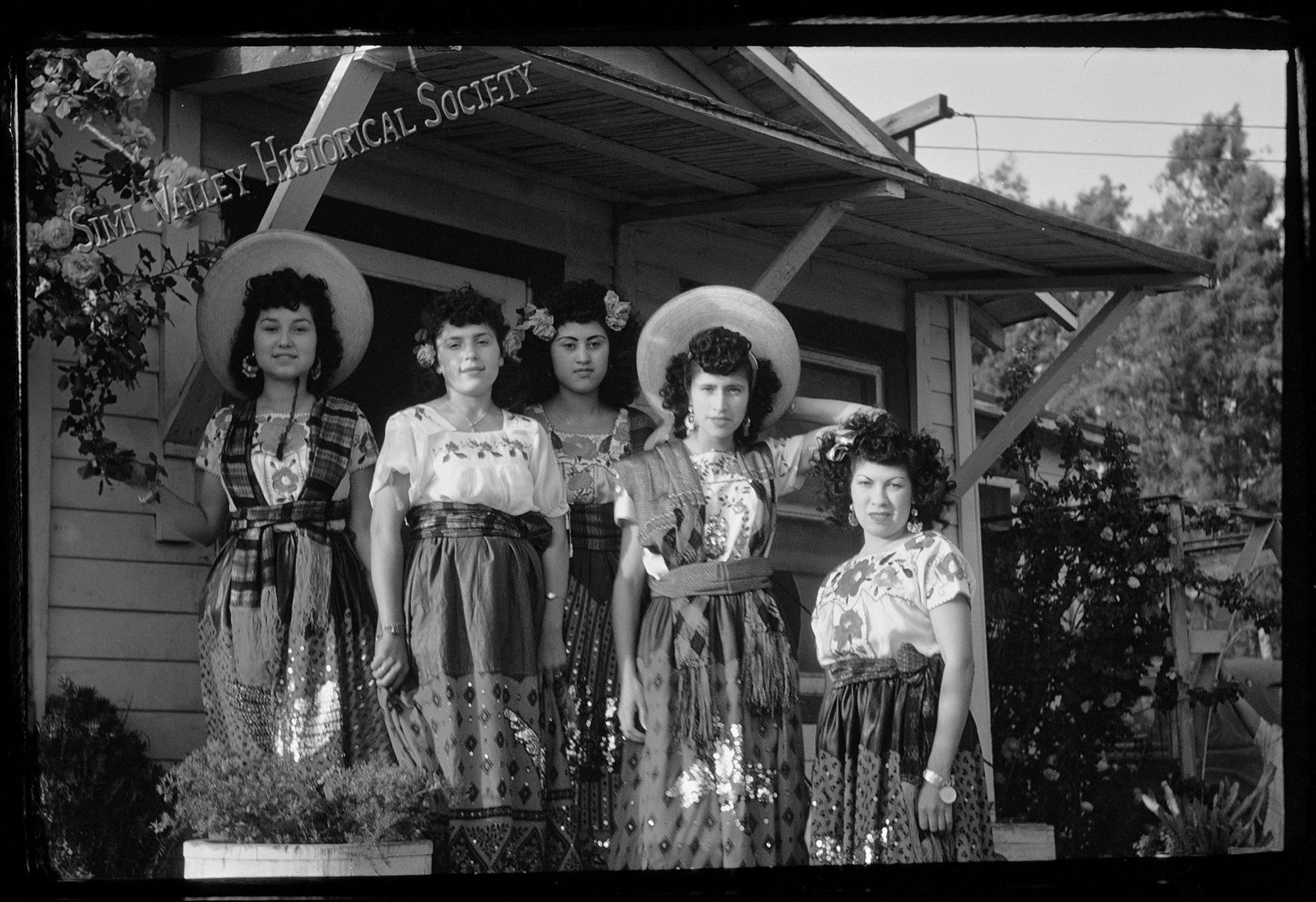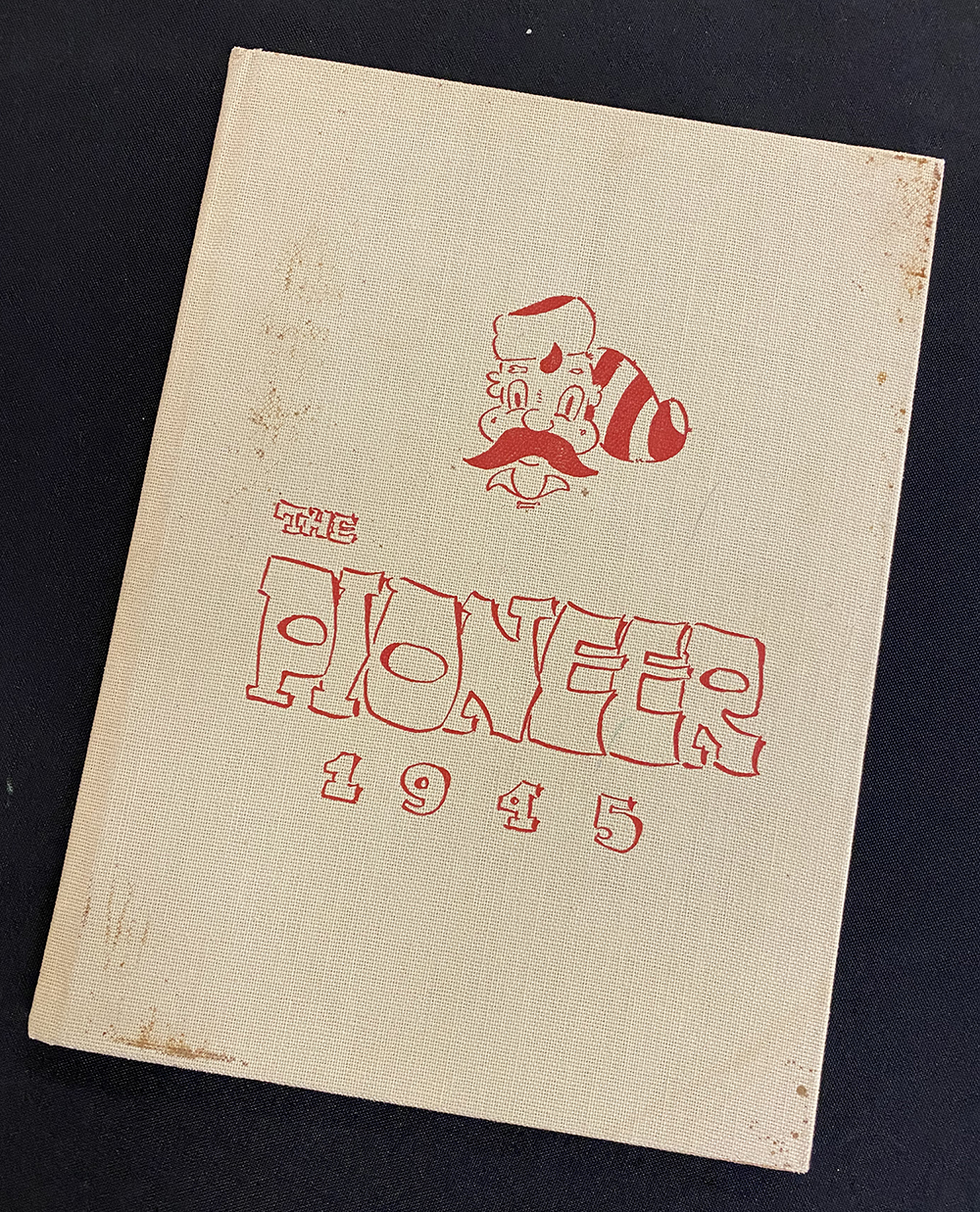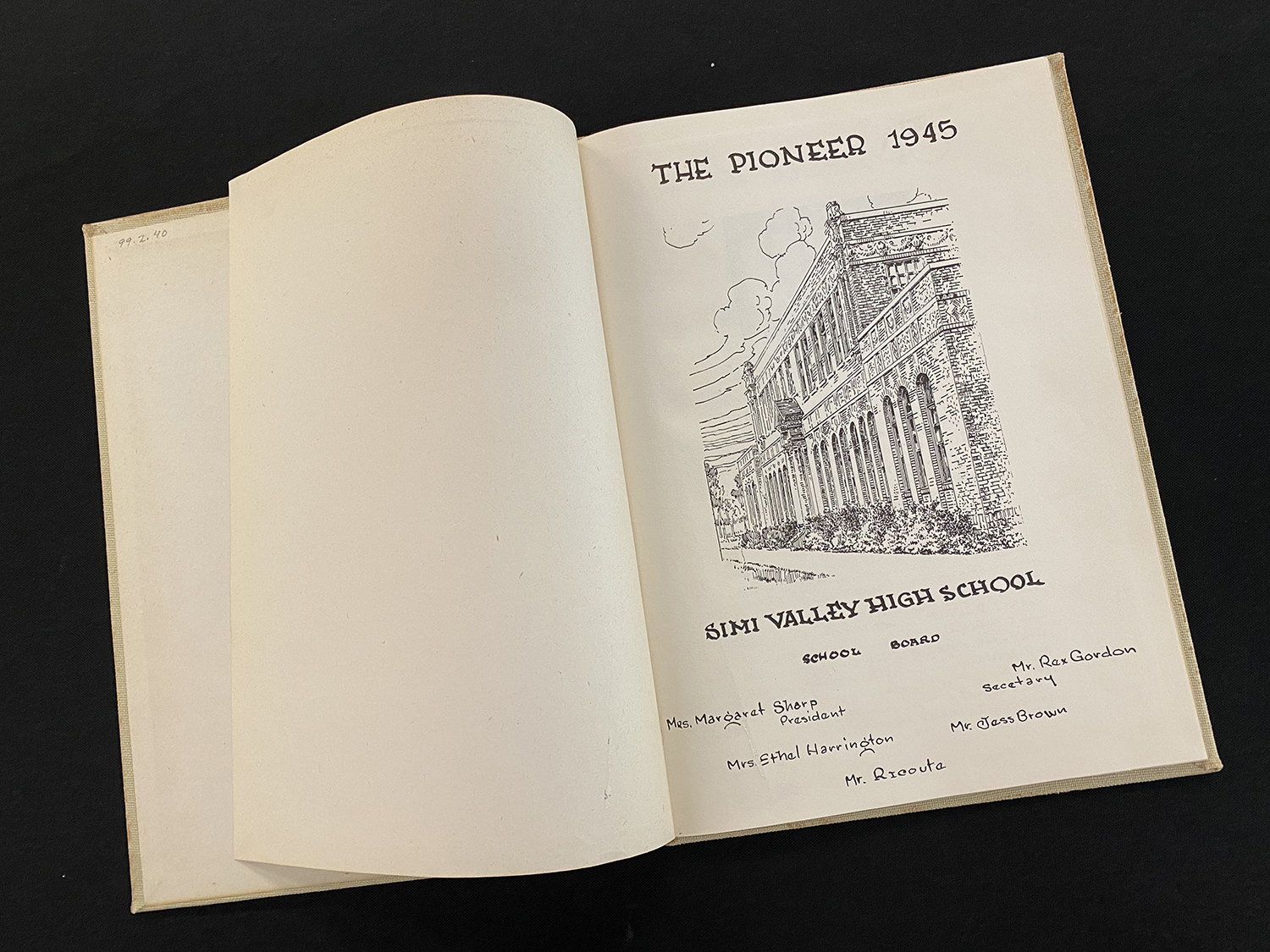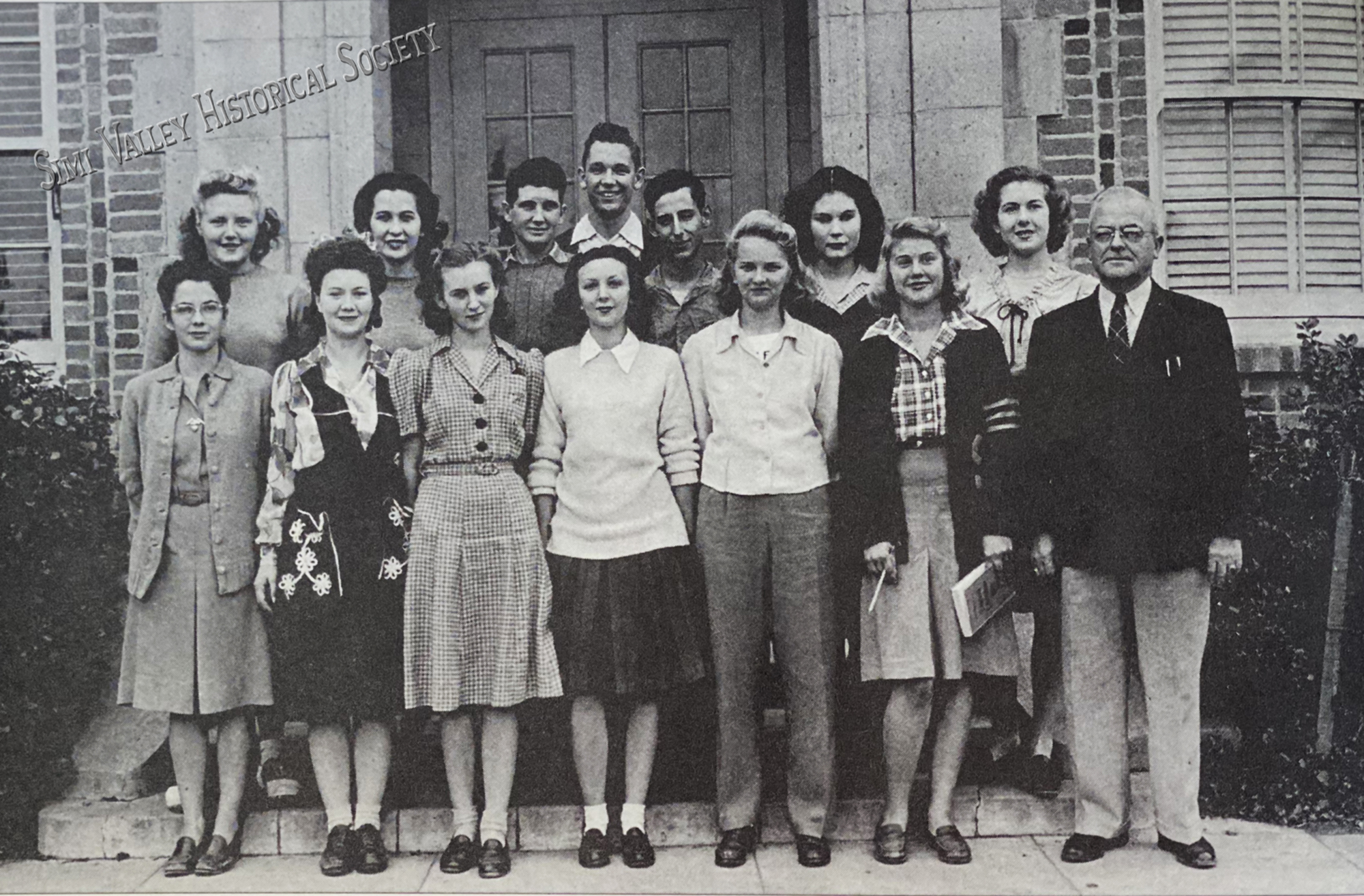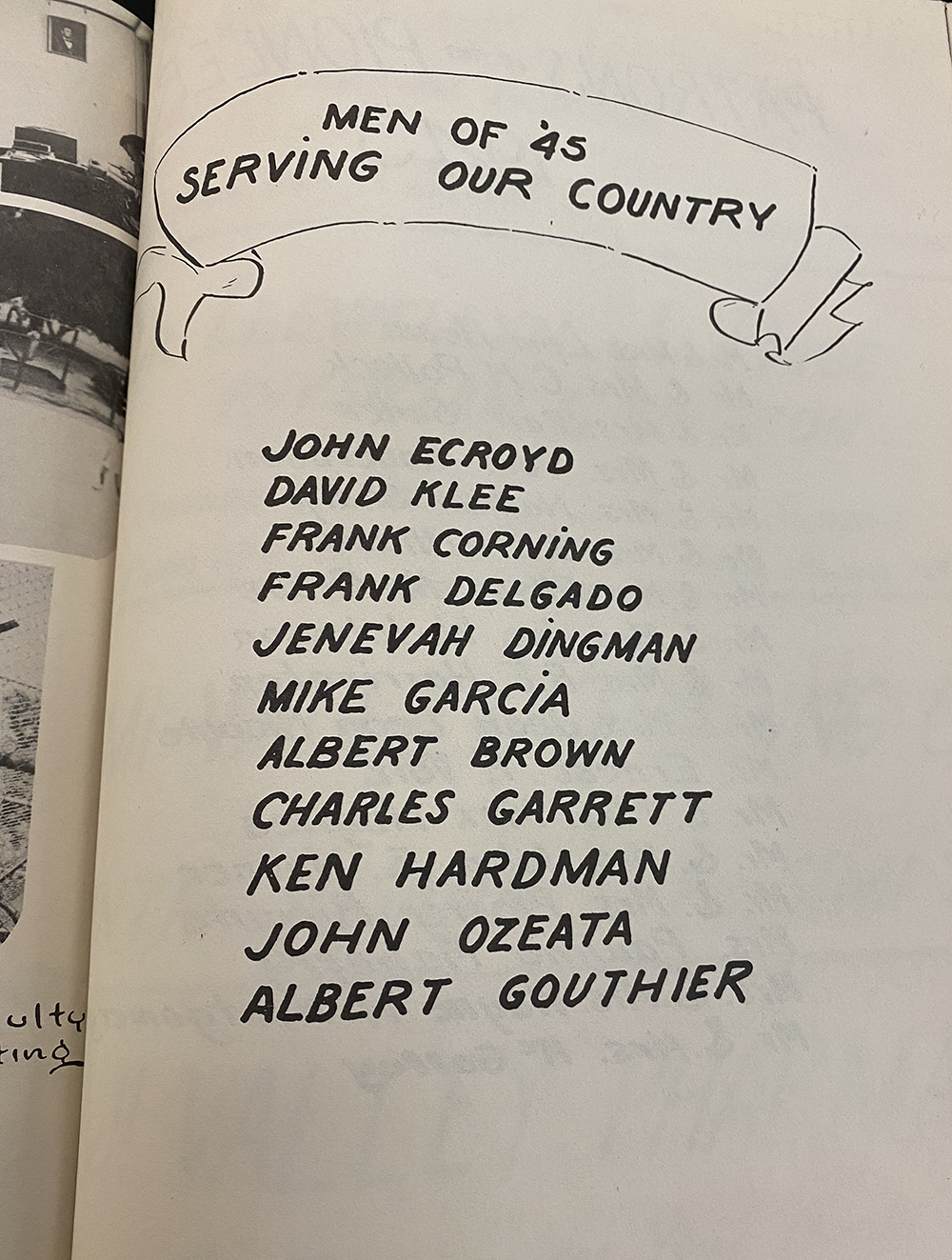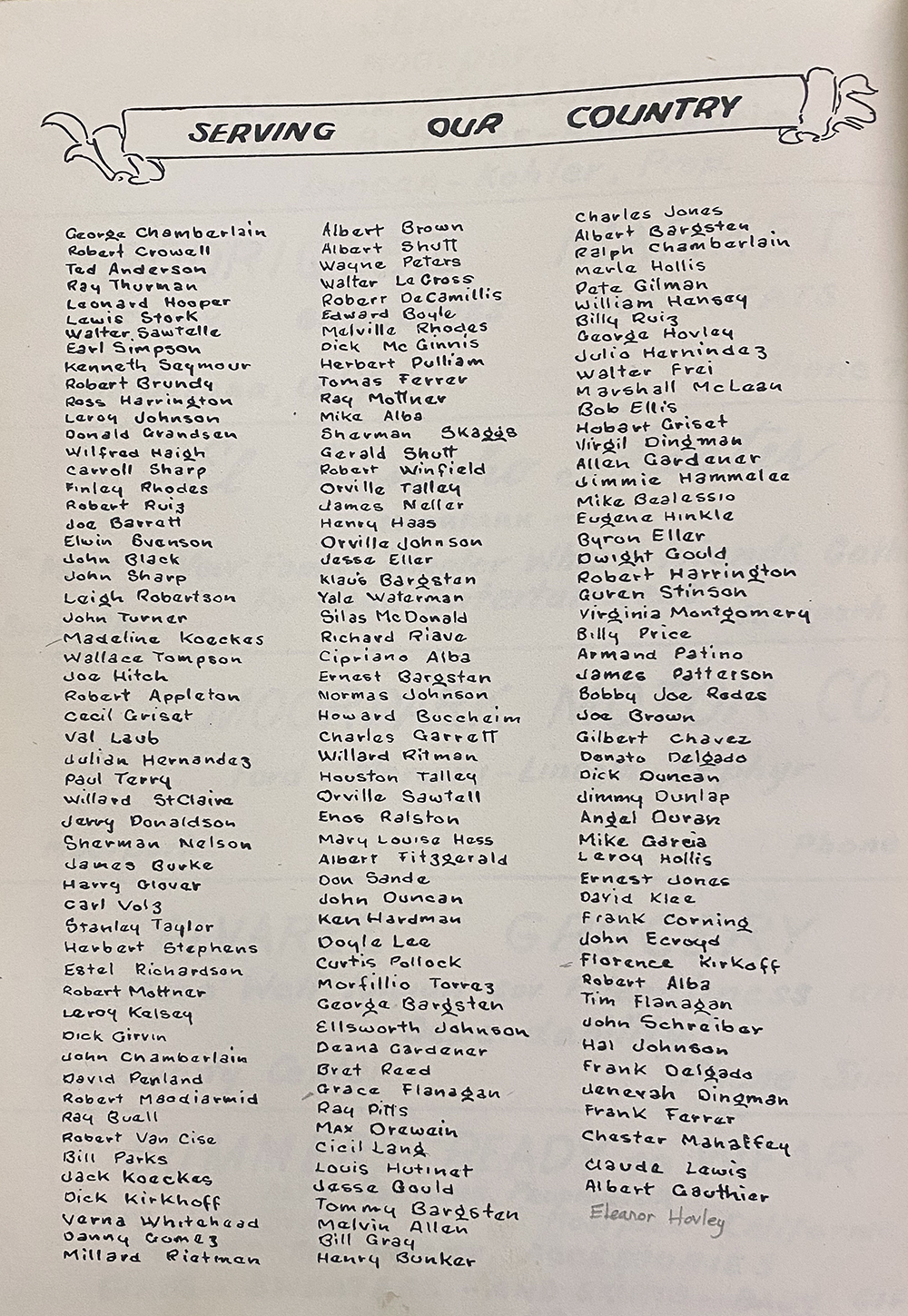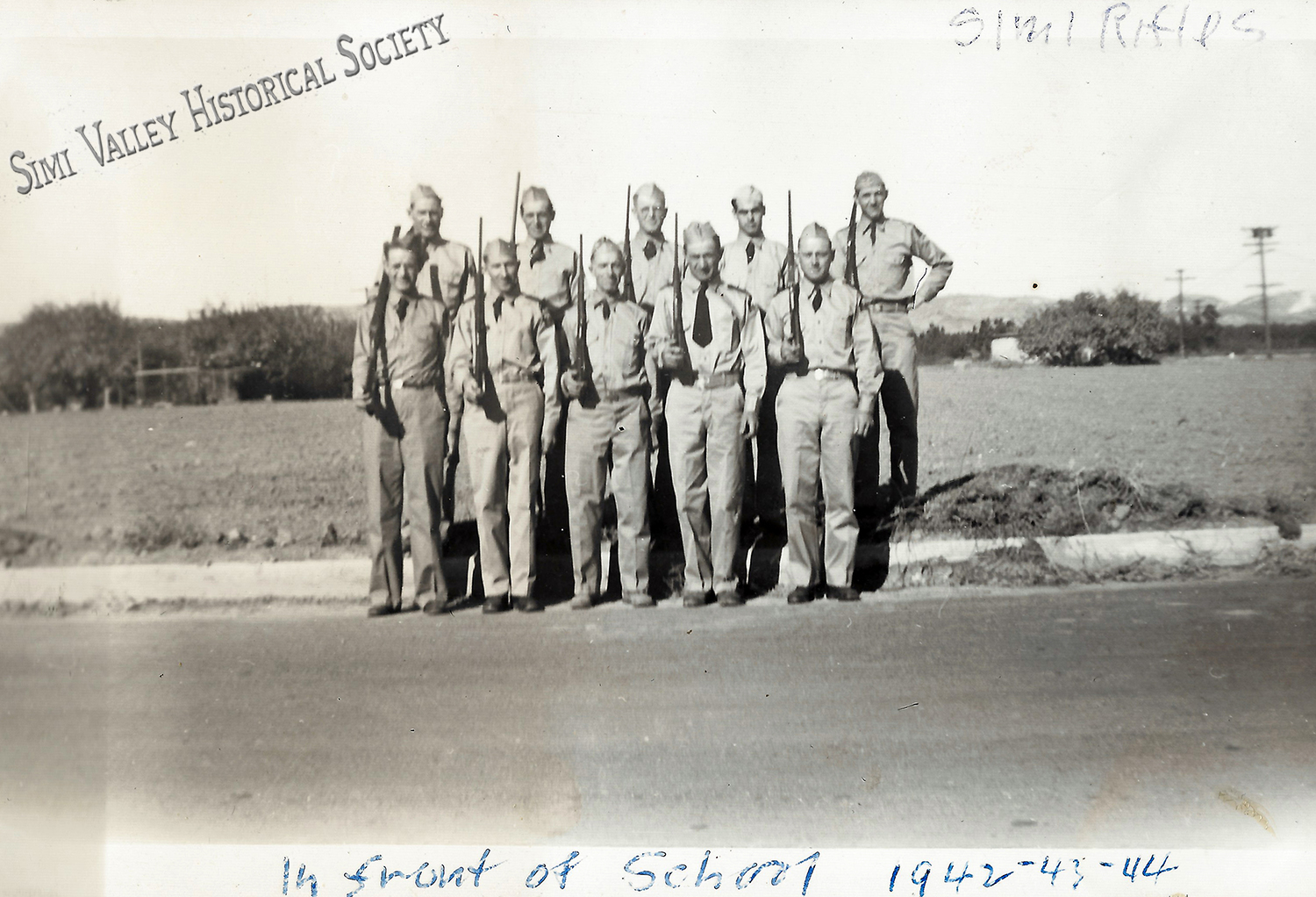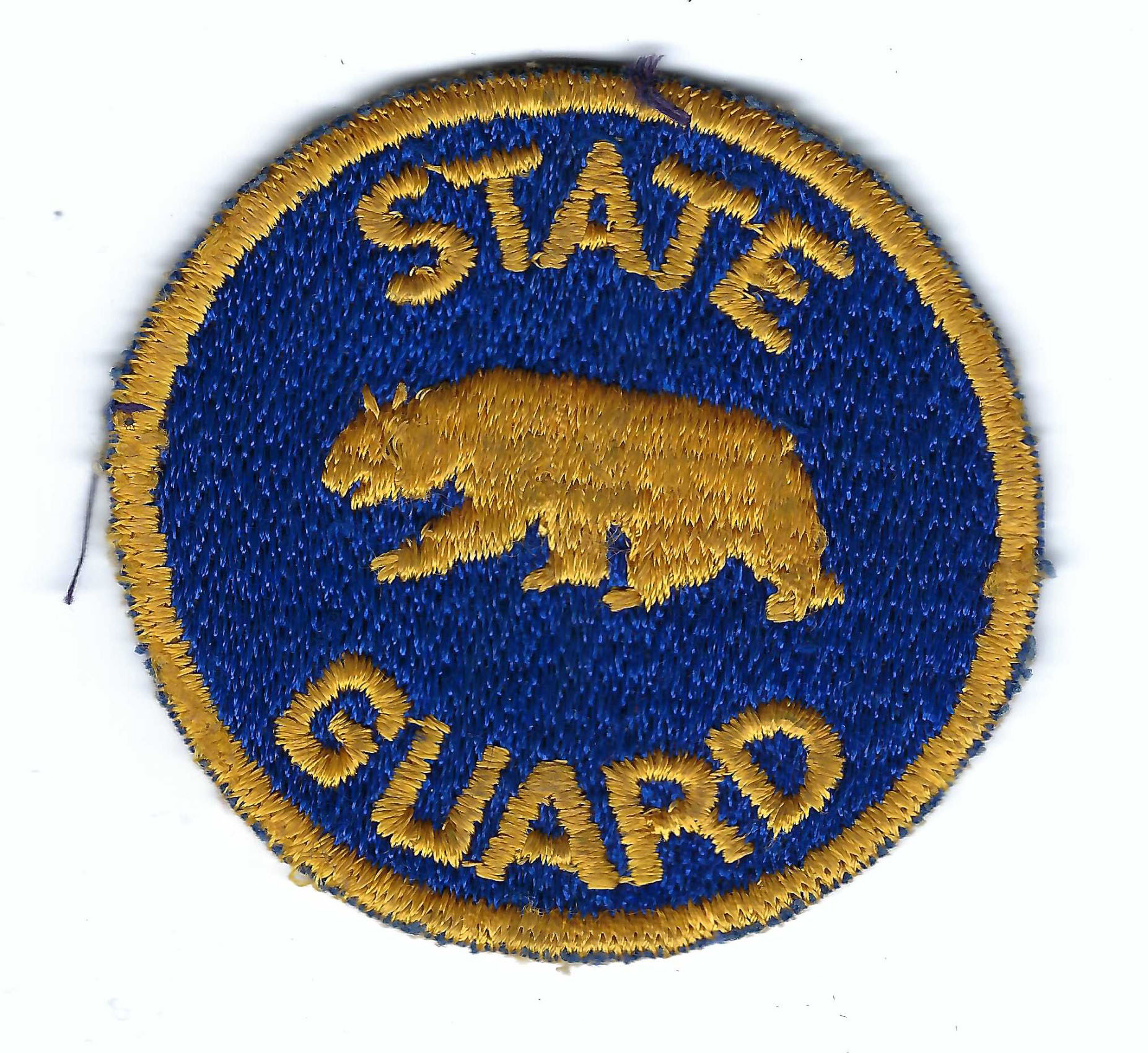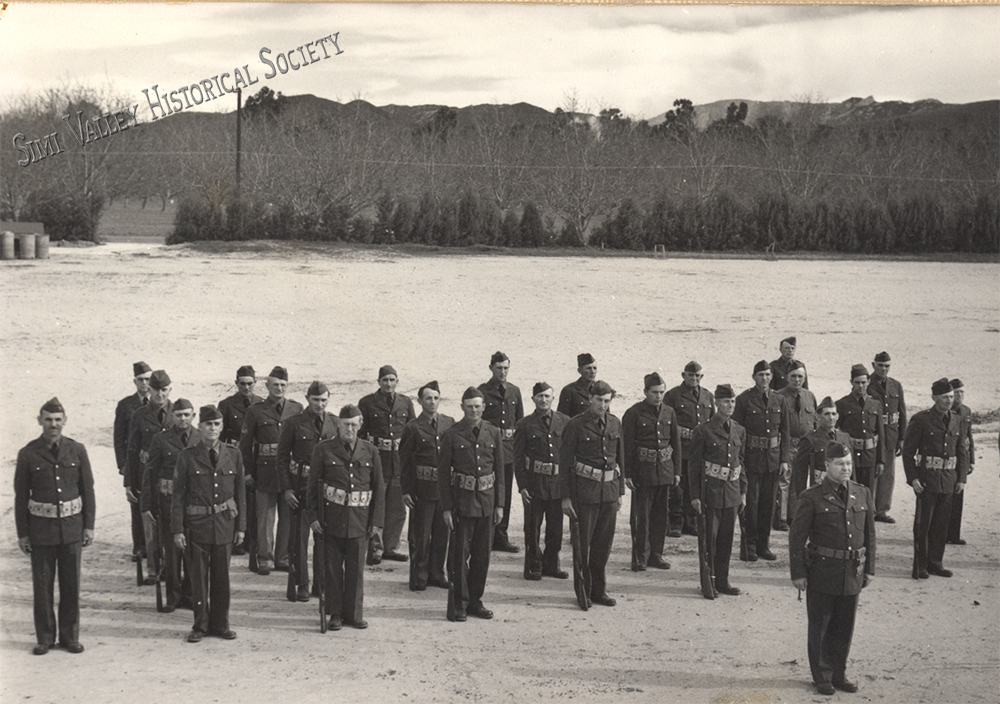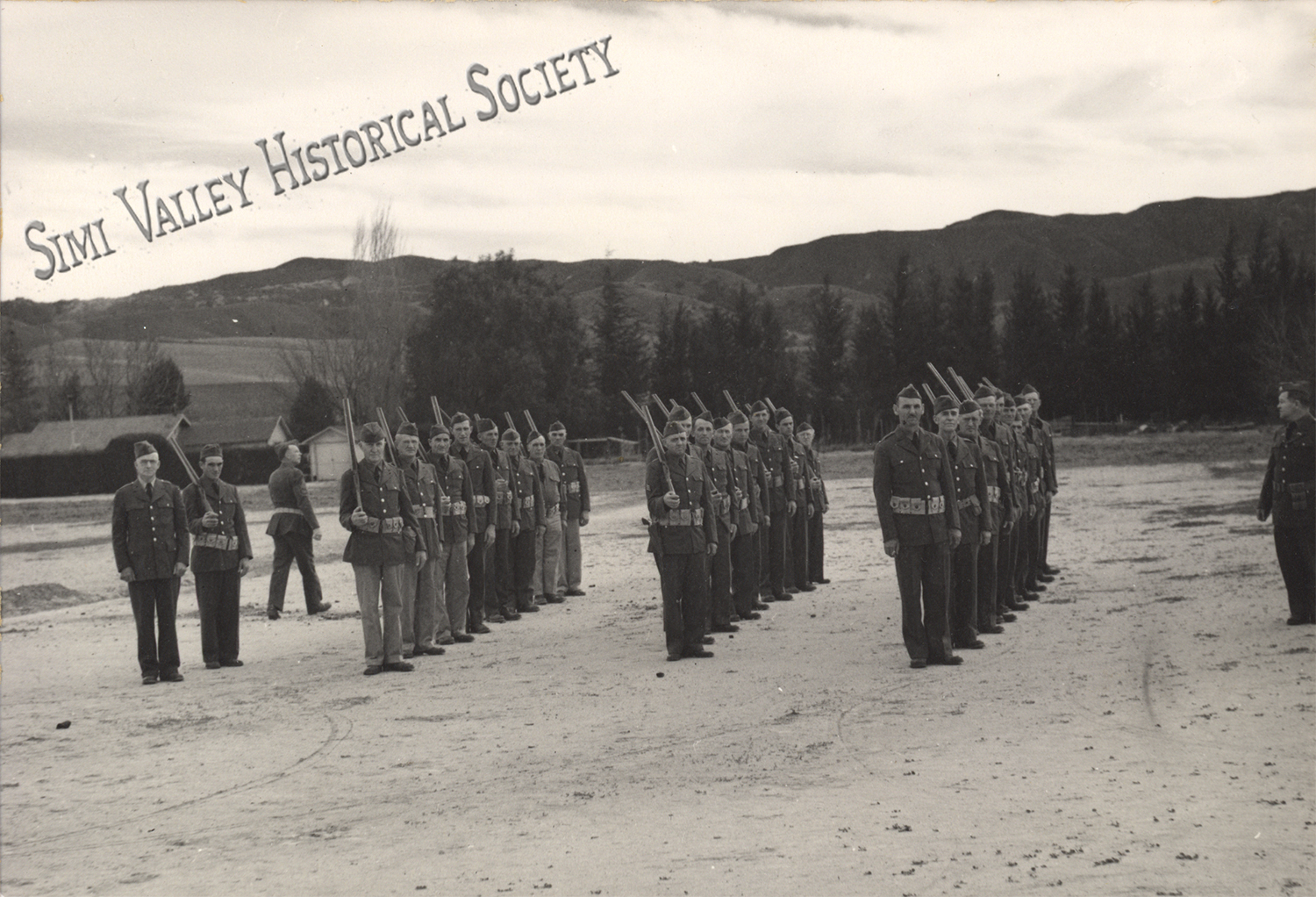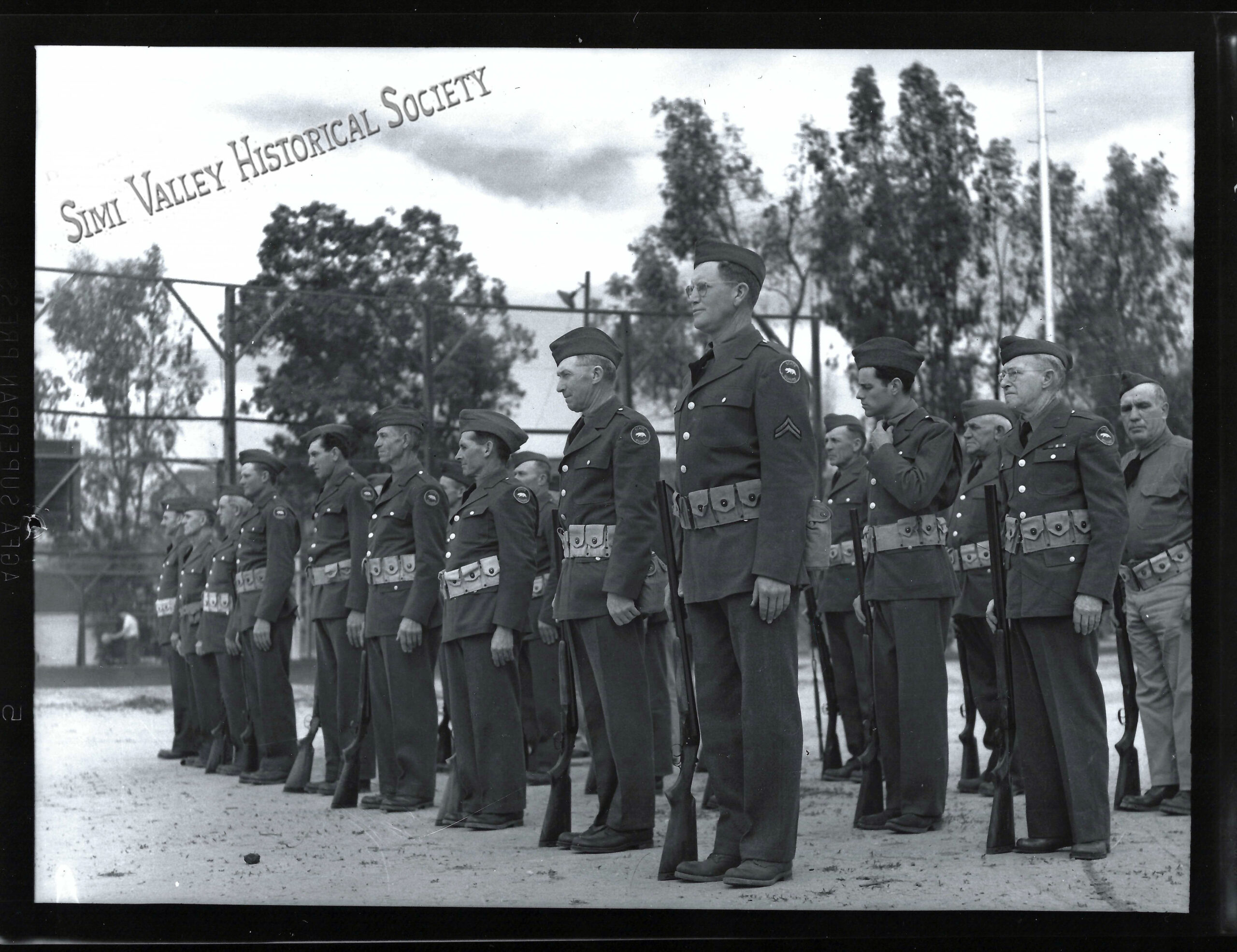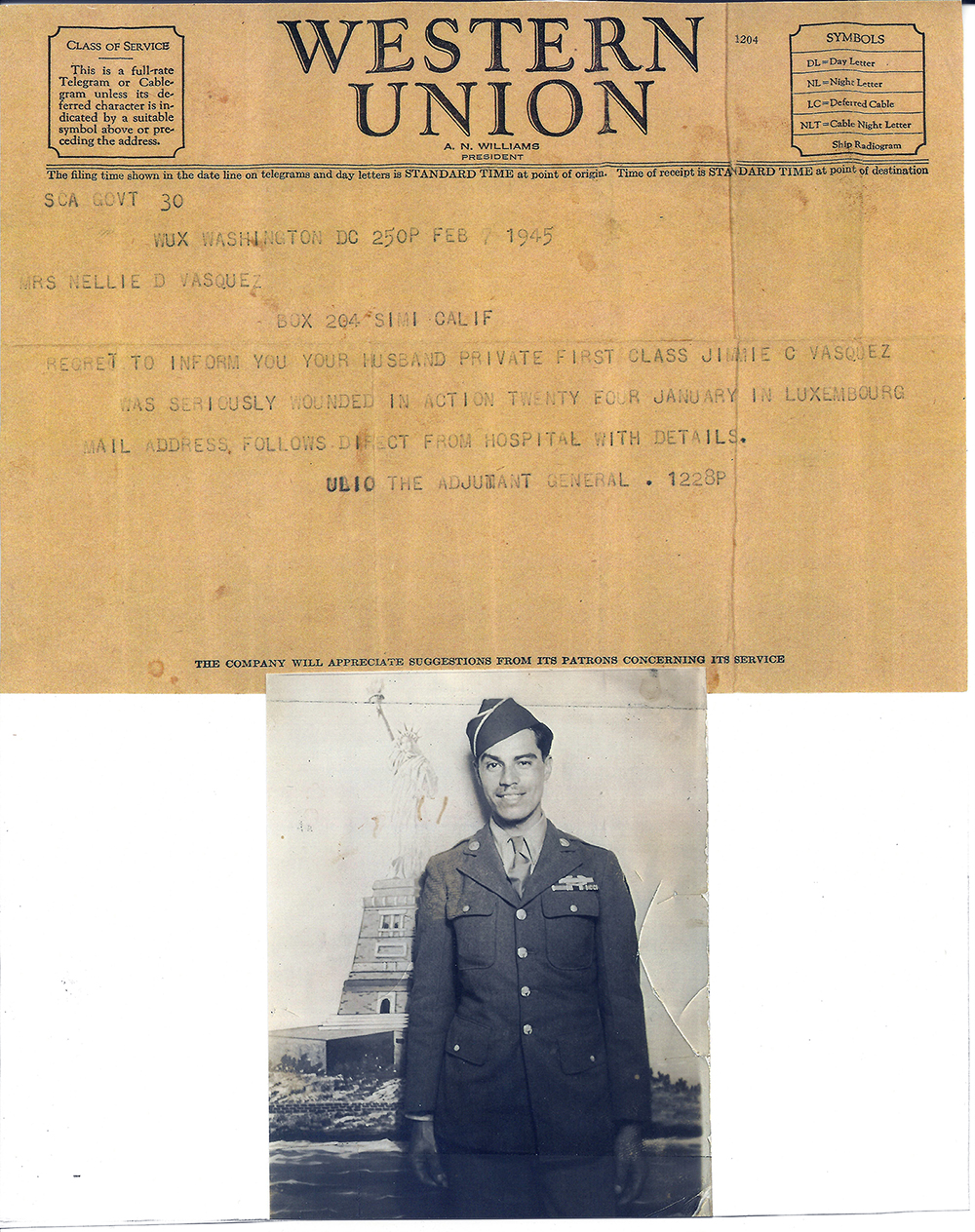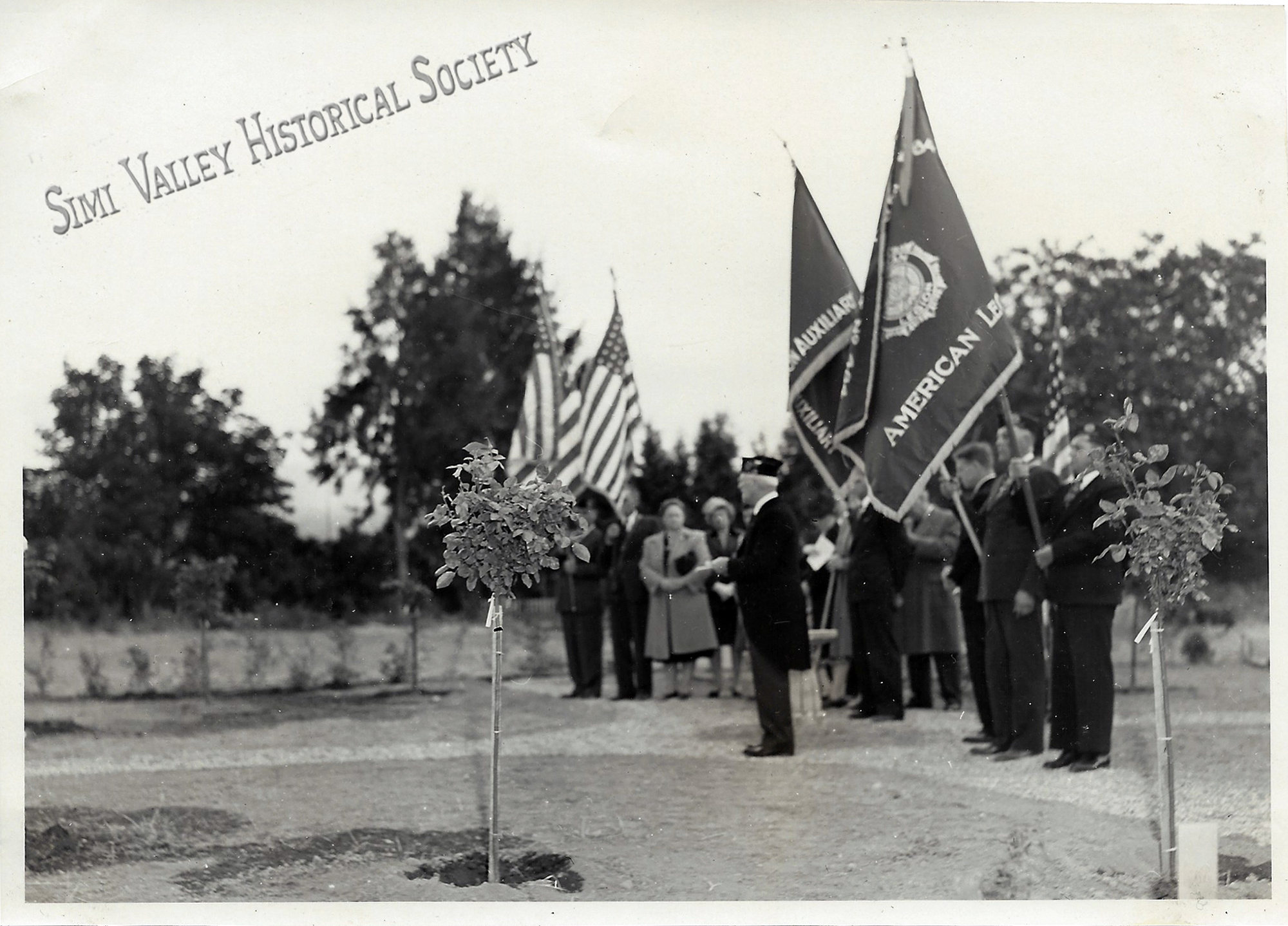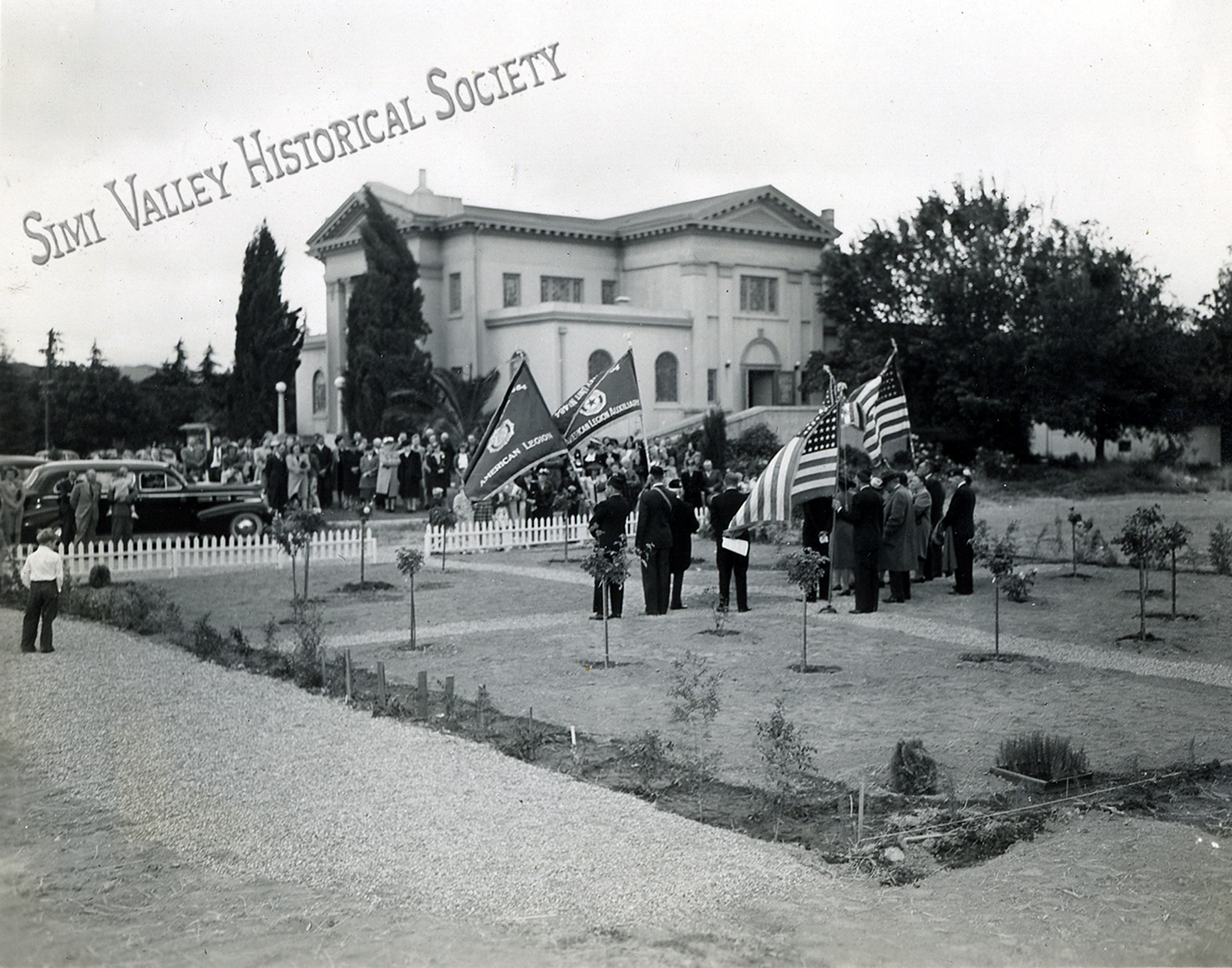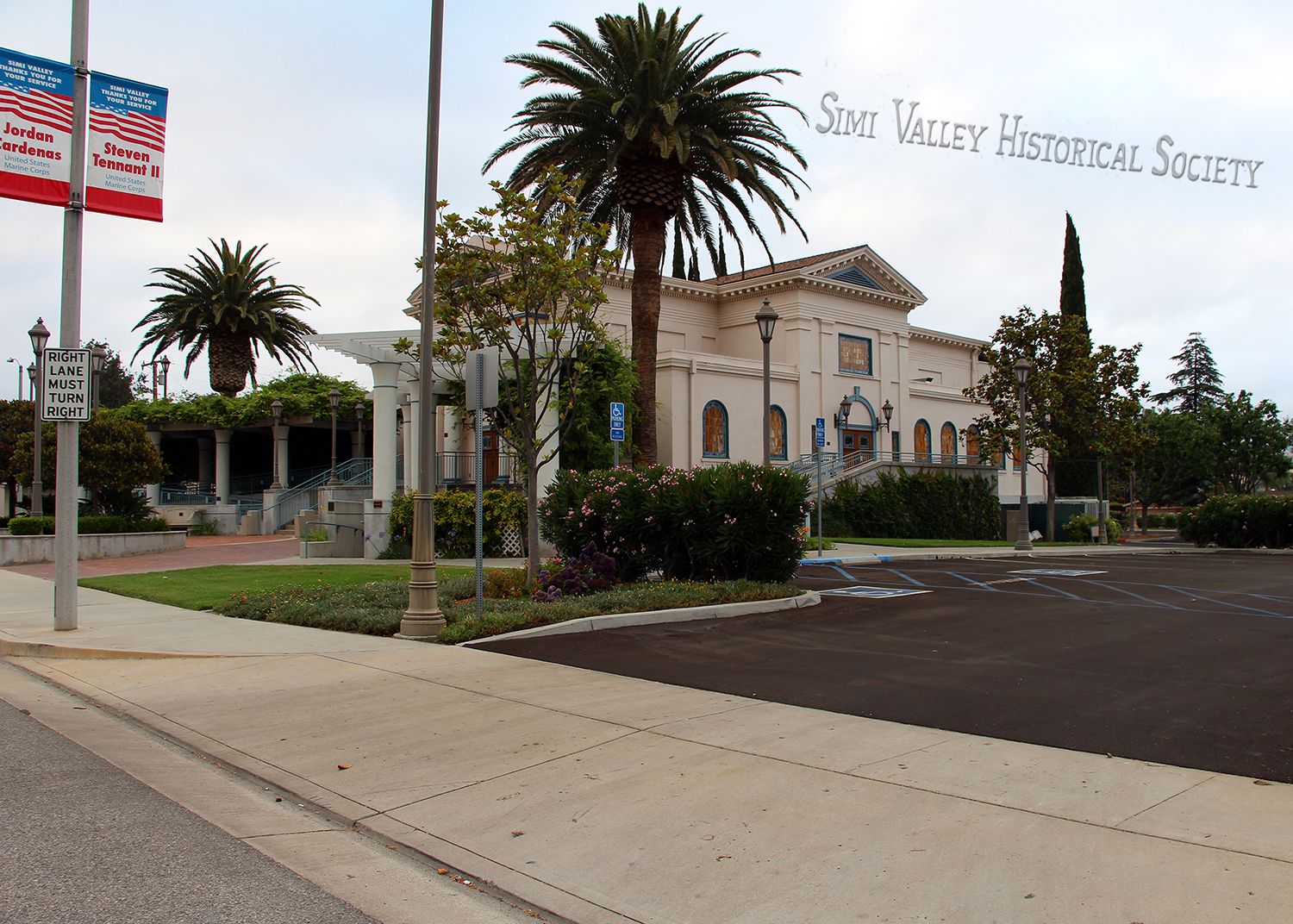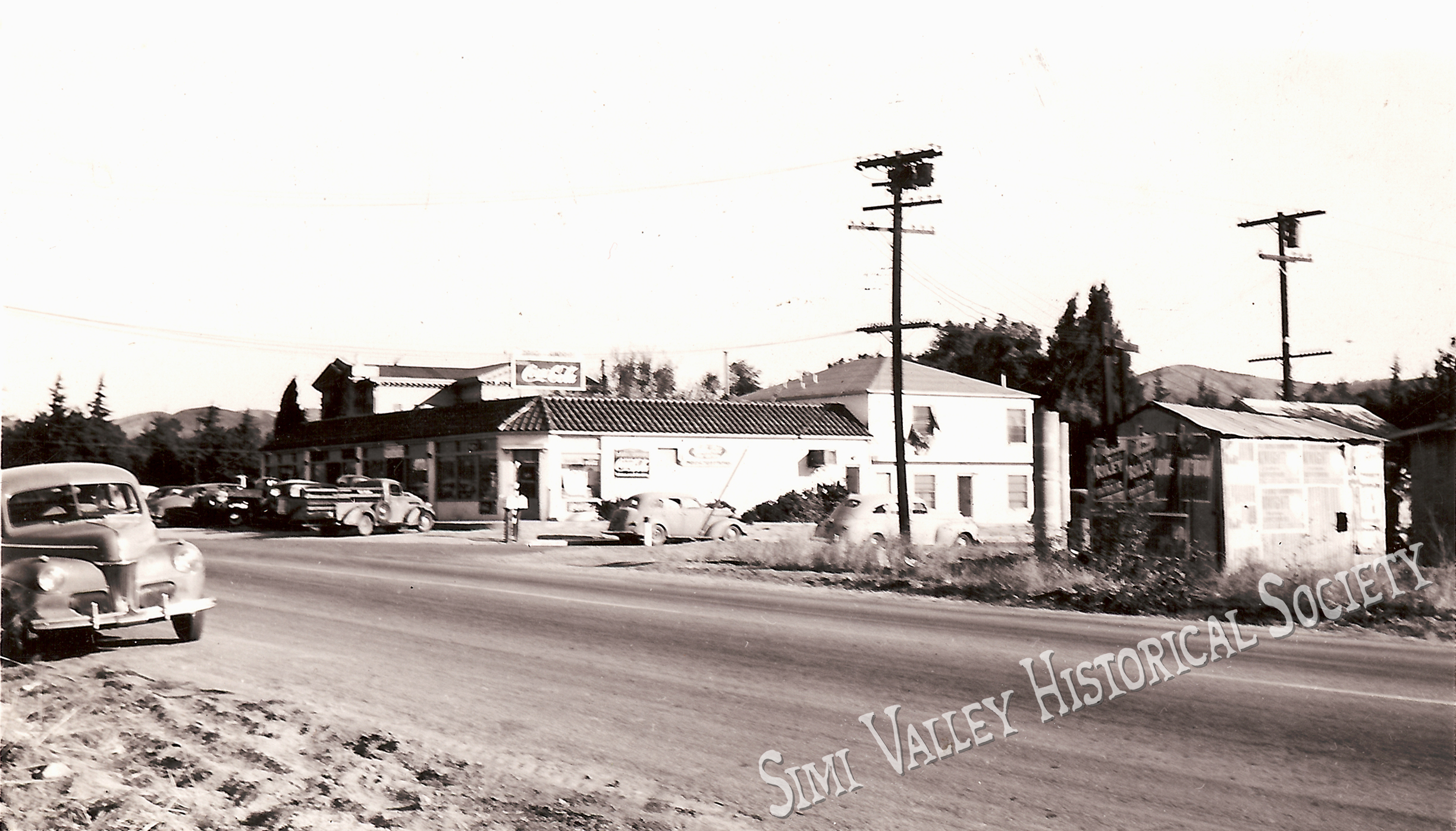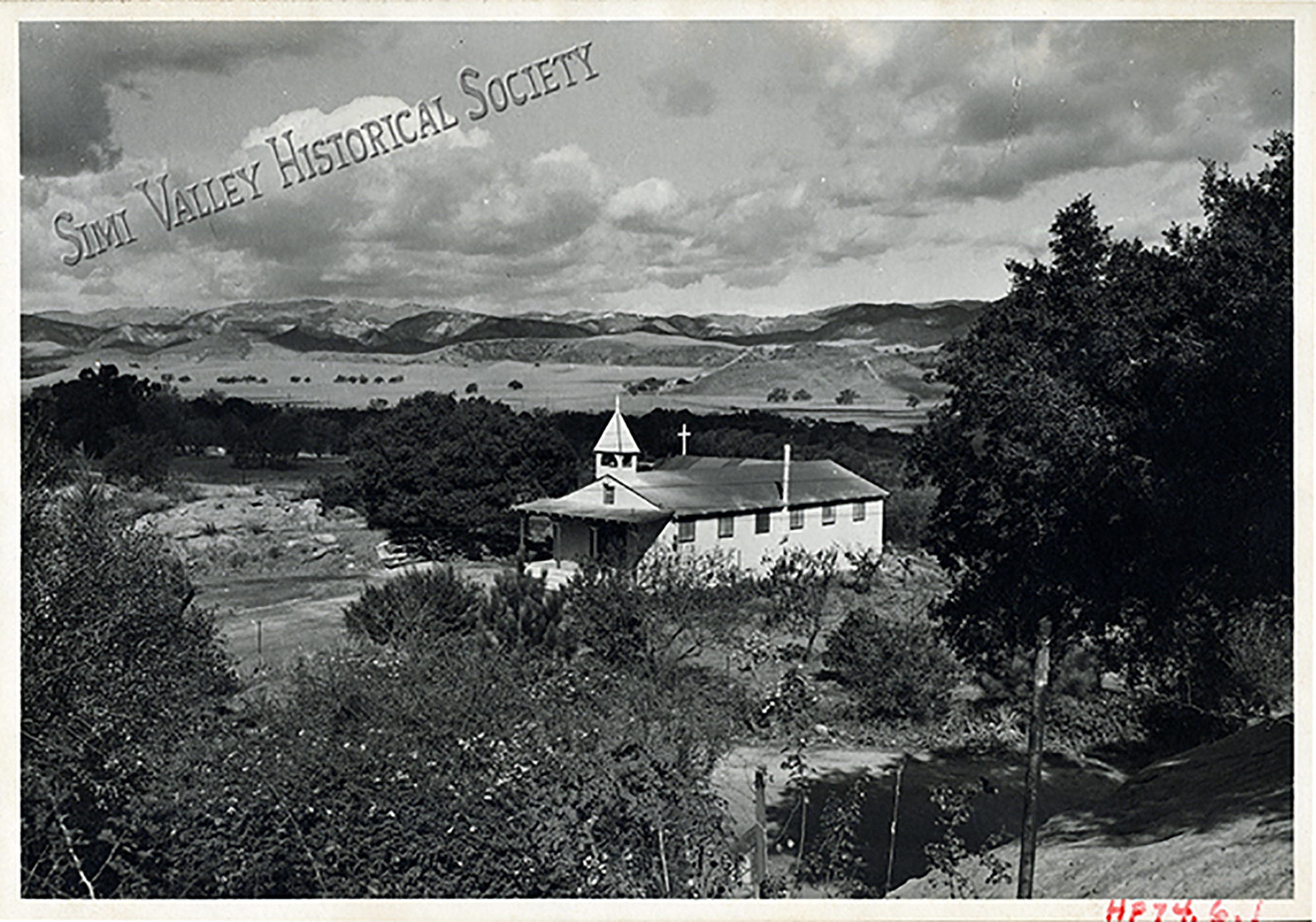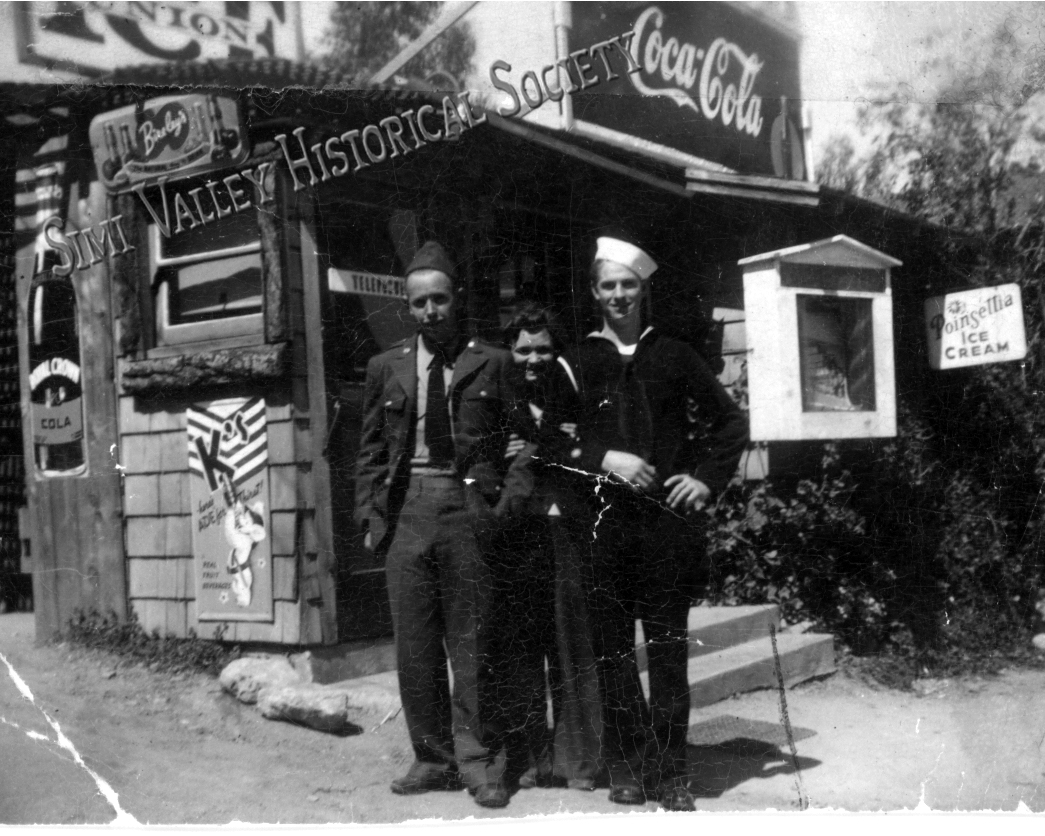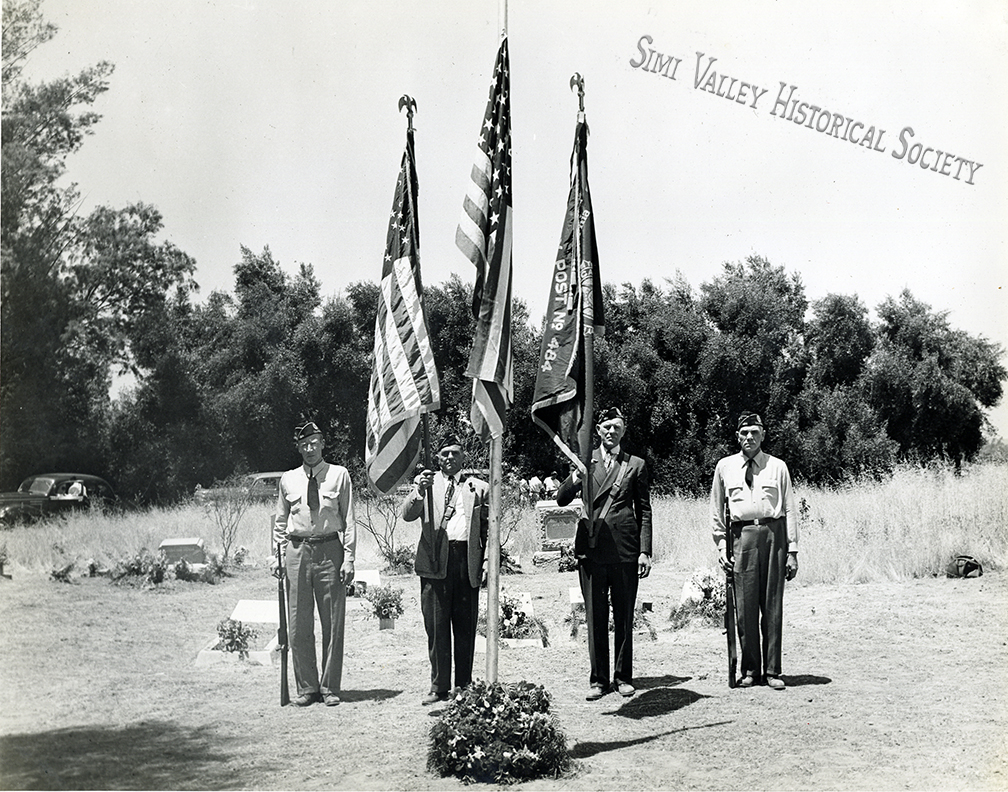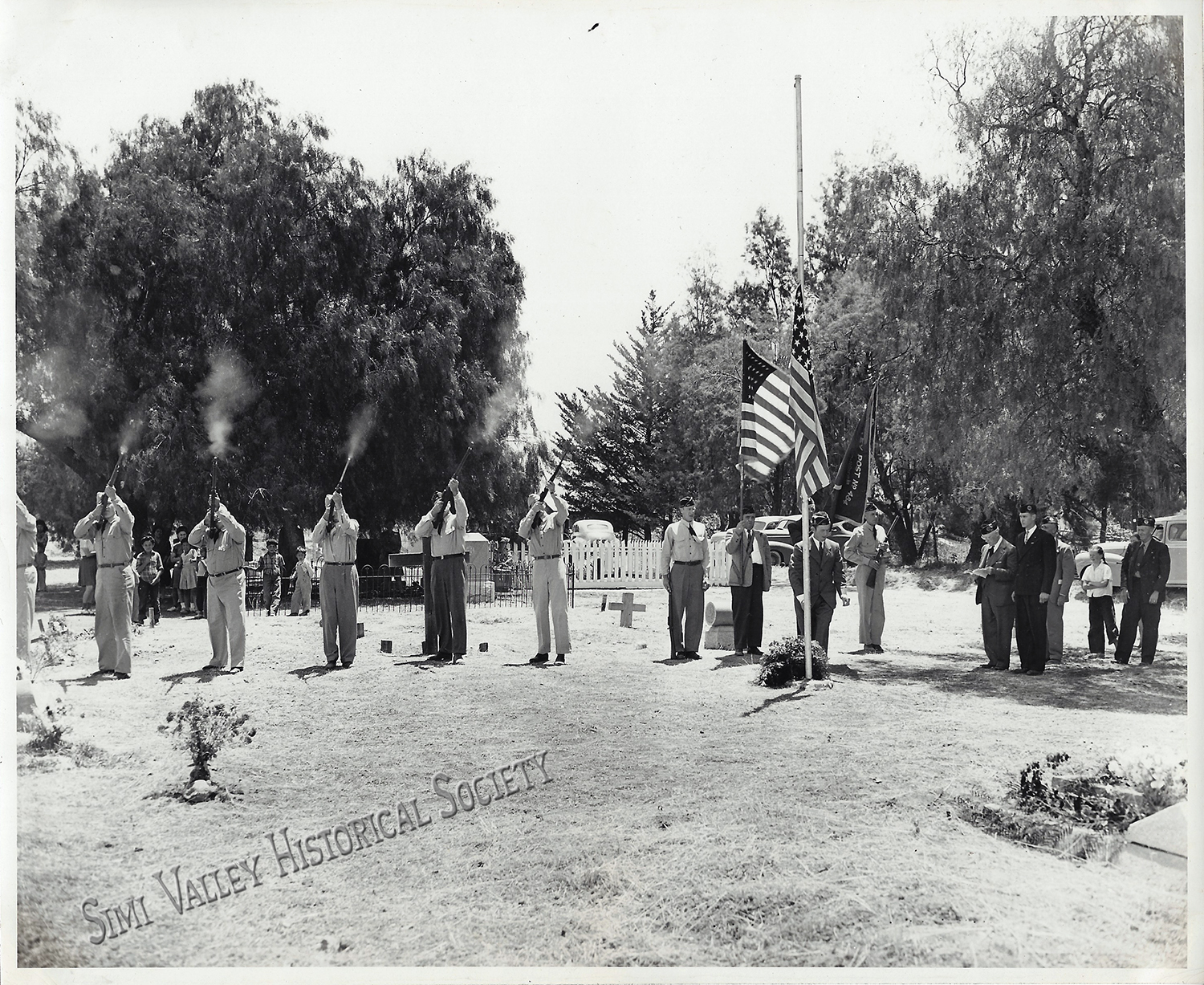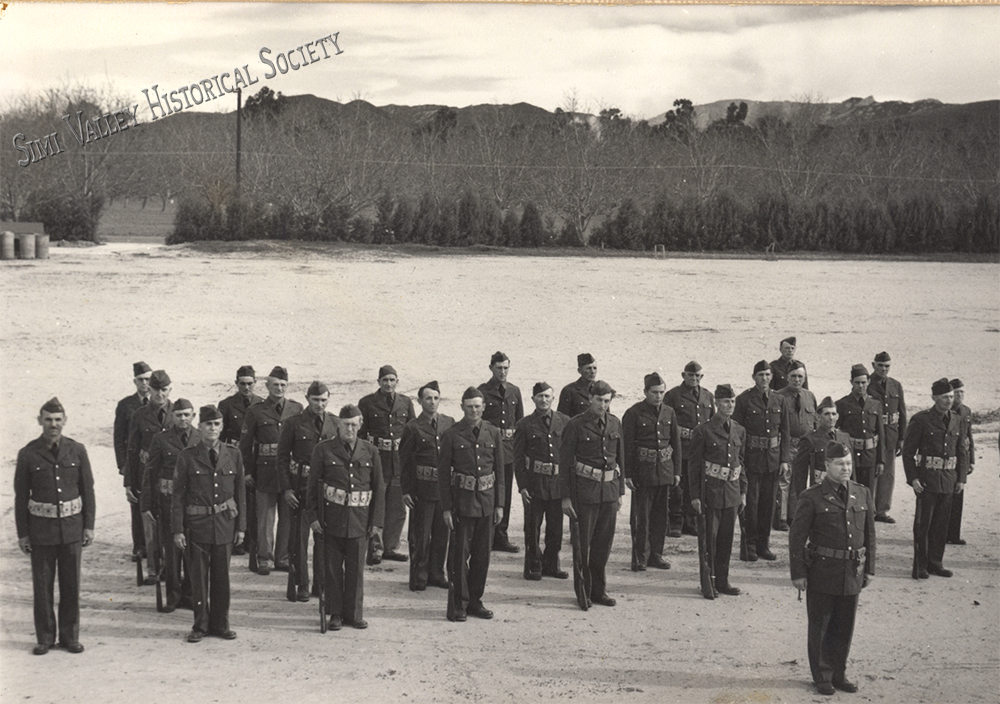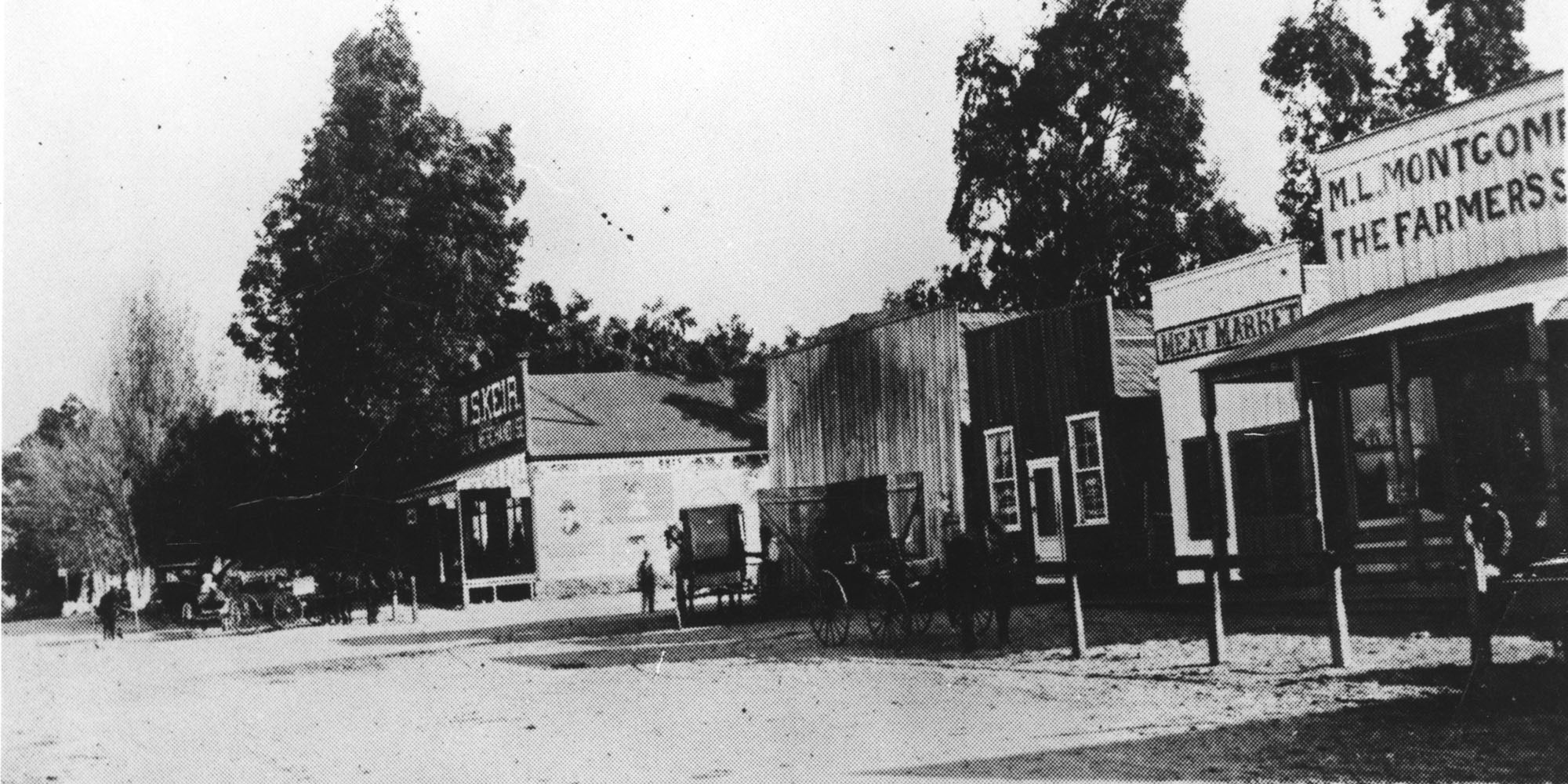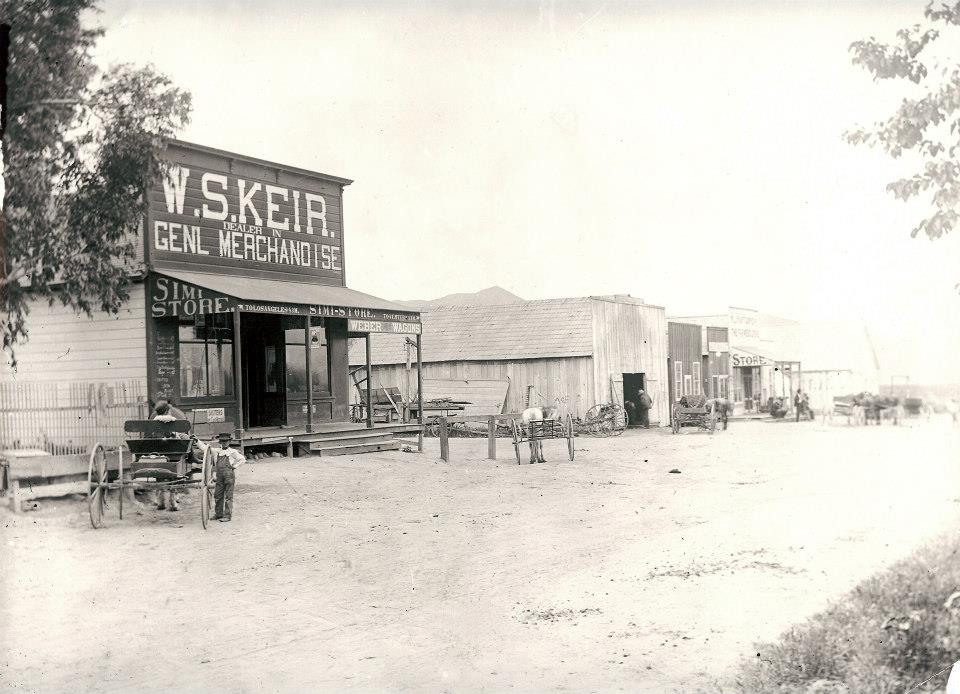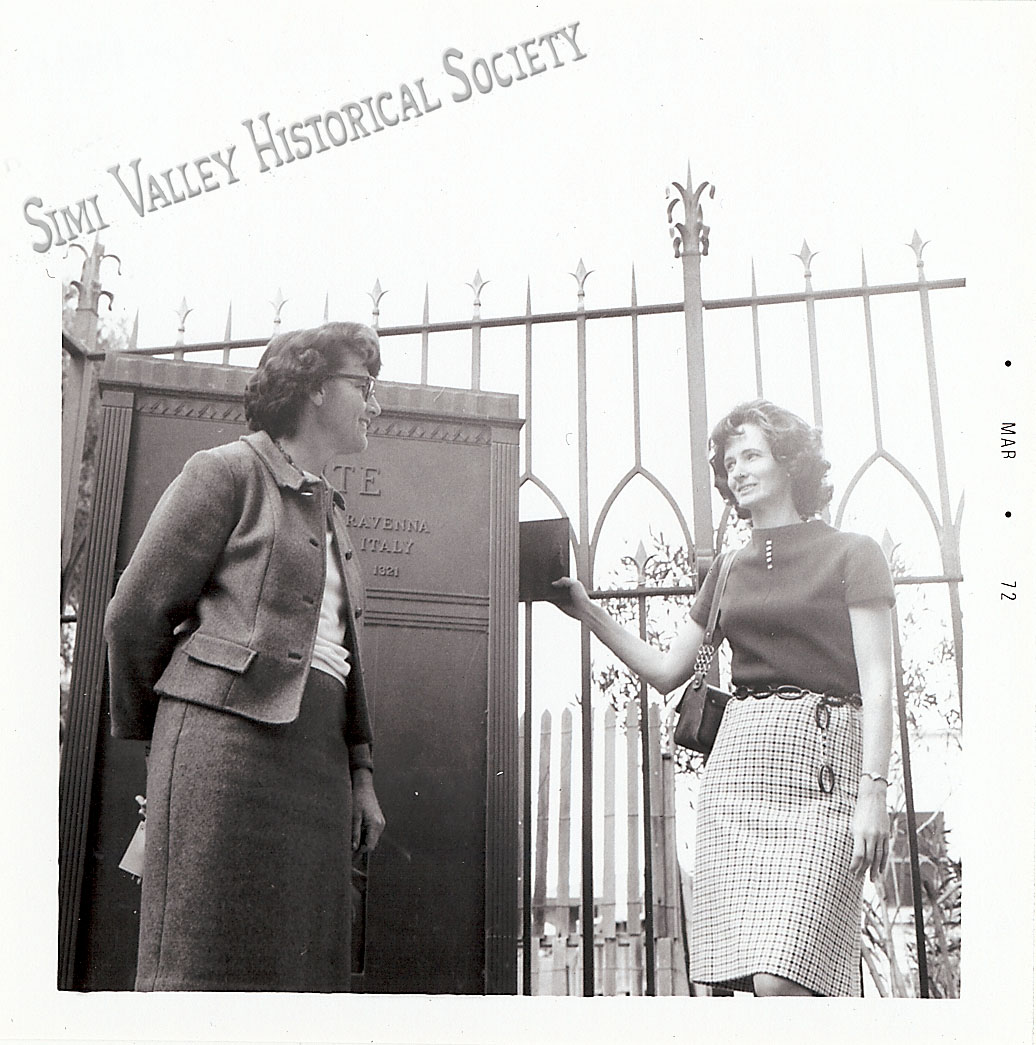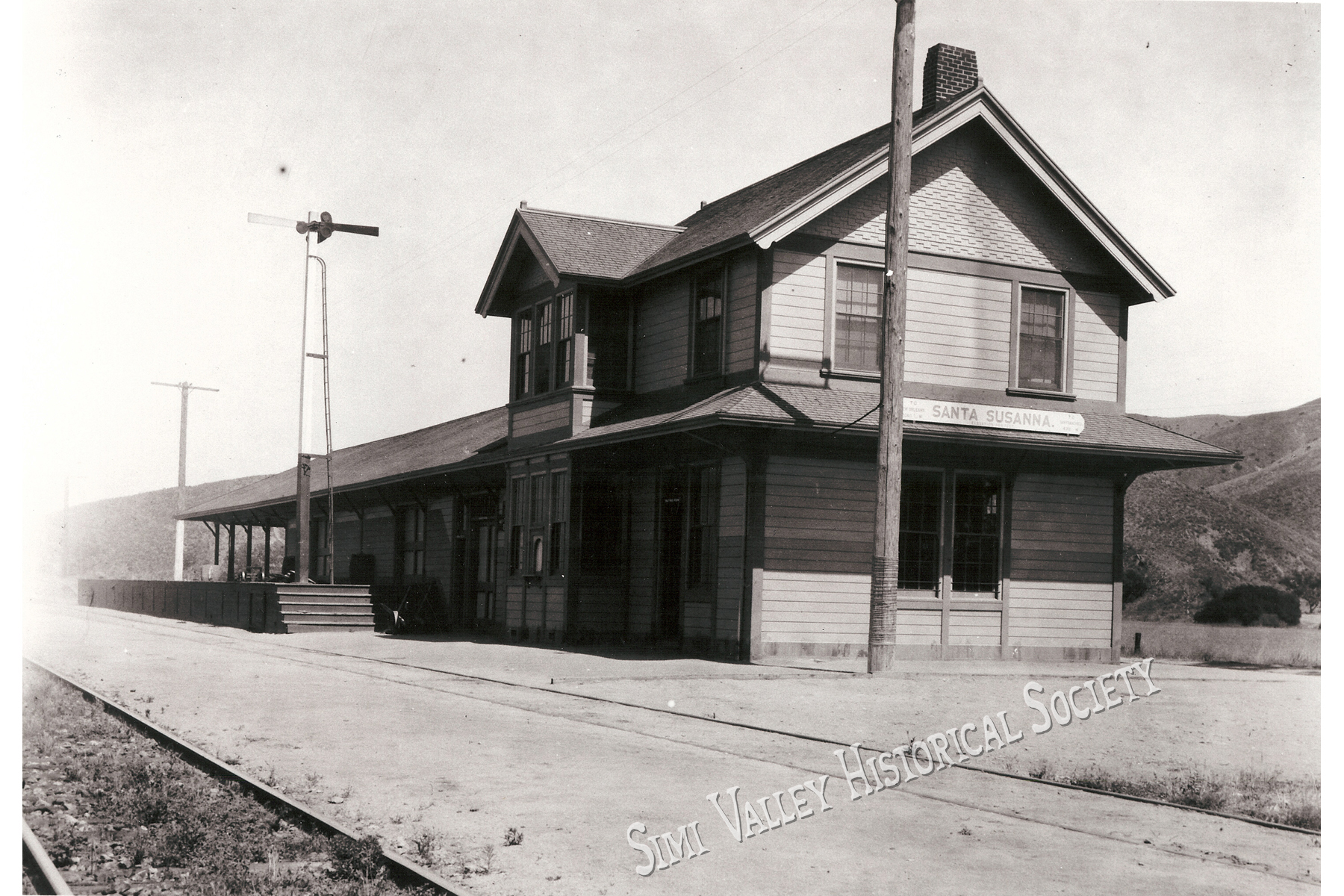Project Description
Simi Valley During WWII
Summer has drawn to a close did you visit the ‘Secrets of WWII’ exhibit at the Reagan Presidential Library? It will only be open for a few more weeks. It’s an amazing exhibit about the events that took place during WWII here in the U.S. as well as on the battlefields in distant places. Have you ever wondered what was going on right here in Simi Valley during that time? Take a look through these photos and read about what was happening right here in Simi…
A 1929 view of Sinaloa Ranch and entire valley
This photo shows Simi a little over ten years prior to WWII, The buildings across the center in the foreground are the workers’ quarters for the Robertson Ranch. They were located on what was then ‘Kujawsky, just south of Pitts.’ Nowadays that would be on Madera just south of Royal. The Robertson Ranch, also known as the Sinaloa Hacienda, was a thriving ranch. One of many that were located in the Valley of Simi.
View from Mt. McCoy in the late 1940s
This photo from the late 1940s shows the view from the top of Mt. McCoy, looking north towards Tierra Rejada and the railroad track. A plume of steam from a train can be seen in the distance. Simi at the time was agricultural, with farms and ranches dotting the Valley. The population in 1940 was 3,406 and would only climb to 4,073 in 1950.
Photo of west end of Simi where current day Strathearn Place meets Madera Road
This is a photo taken in the 1940s looking northeast at where (the current) Strathearn Place meets Madera Road. This visible structure is where Hamish and Jessie Strathearn MacDiarmid raised hens. The land in the foreground is where the Target shopping center is now. This beautiful photo is by William H. Appleton and is courtesy of the Bill Appleton Collection. It is on page 194 of the unbelievably informative book 'Simi Valley-A Journey Through Time.'
Los Angeles Ave. and 4th Street. Simi-looking west c. 1946
A photo looking west on Los Angeles ave. c1946. The gas station on the left was located on LA Ave and Third st. Just past the bicyclist in the street is where the Bañaga barbershop sat from 1958 through 2006 (it’s now at Strathearn). Initially built in the early 1900s, at the time this photo was taken the building was probably a cafe. The building just on the other side of the barbershop was the post office. This photo is by Hildreth Lee Appleton, courtesy of Bill Appleton.
Looking east looking from approximately Los Angeles Avenue and Fifth Street c.1946
Now looking east looking from approximately LA Avenue and Fifth Street c.1946. The Simi Grocery building on the south side of LA Ave. is now the Enterprise Rent-A-Car office, the white structure across the street from that is still there. Photo by Hildie Appleton, courtesy of Bill Appleton. This area is the oldest townsite in Simi, and was once known as ‘Simiopolis.’
Santa Susana Train Depot c1945
The Santa Susana Depot was originally located just east of Tapo Street on Los Angeles Avenue. It was constructed by the Southern Pacific railroad and completed in March 1903. The second story of the Depot located above the office and waiting room provided living quarters for the station agent and his family. The Depot brought quite a change to Santa Susana. Telegraph and long distance transportation facilities became immediately available to the community. Passengers could travel in relative comfort and citrus and walnut growers could now transport huge shipments without depending on the horse and unpredictable weather. The Depot was relied upon heavily during the war years for transportation. The Depot continued to be a hub of activity into the 1950s, but then other forms of transportation became more popular and prevalent than train travel. The agency was closed in 1964, and only the warehouse which was leased, continued to operate. In 1974 Southern Pacific announced plans to demolish the Santa Susana Train Depot building. Rancho Simi Recreation and Park District purchased the depot for $1.00 and .06 tax.
Moorpark Enterprise -June 26, 1941
Here’s an advertisement published in the Moorpark Enterprise In the first year of WWII on June 26, 1941 for Railroad Travel. From Los Angeles to Chicago for $65 roundtrip? Sounds like a deal, doesn’t it? $65 in 1941 is actually between $1200 and $1300 in 2022 dollars!
Moorpark Enterprise -July 23 1942
Blackouts in Southern California in which windows and headlights were darkened to keep lights from delineating possible war targets added to drama to the times. As WWII continued, blackouts were necessary to obscure locations from being targeted for attack by aircraft. In this ad published in the Moorpark Enterprise on July 23, 1942, Southern Pacific explains how they do their part in preventing attacks on the railway.
Moorpark Enterprise -November 16, 1944
The beginnings of the Santa Susana Airport occurred prior to WWII, when the land was graded and used as an airstrip. Restrictions due to the war stalled plans to officially open the airport. Chet Foster purchased the land, and after the wartime restrictions began to ease, the Santa Susana Airport was born. Runway Street, in the industrial area southeast of Los Angeles Ave and Tapo St. is the last vestige of the airport which closed in the late 1970s.
View of Airport -Los Angeles Ave at Tapo St. c1940-1945
The intersection of Los Angeles Ave. and Tapo Street taken in the mid-1940s looking east. South across the original location of the Santa Susana Depot was the Airport. The Crinklaw Building which once stood on Los Angeles Ave is visible, right across the Railroad Depot in its original location. This photo is on Pg. 364 of the extremely informative book "Simi Valley- A Journey Through Time." Photo by Wurtz
Lt. Mike Alba – A Hometown Hero
The Alba family lived and worked the land off of First St before Michael graduated from Simi High and moved to San Fernando. Historian Pat Havens recounts: “Mike was an excellent student, but his Dad did not want him to go to high school, much less college. He wanted him to go to work, help support the family. The Army Air Force insisted he finish college, so he would be eligible to do a lot more. Eventually he helped to ferry P-38s to the Bay Area to be sent to the war. The flight path was right over Simi Valley. Mike would let the family know when to expect them. They would step out from the trees where they were picking walnuts, and Mike would tip the wings of the plane he was flying so they would know which plane he was flying! One of his younger brothers told us that story. It might have been Bobbie Alba.”
Air Observation Posts in Simi and Santa Susana
The Aircraft Warning Service (AWS) was a civilian service of the United States Army Ground Observer Corps instated during World War II to keep watch for enemy planes entering American airspace. It became inactive on May 29, 1944.
Around seven in the evening on Feb. 23, 1942, while most Southern Californians were listening to President Roosevelt’s fireside chat on the radio, explosions were heard near Goleta.
It was a naval attack by a Japanese submarine against United States coastal targets near Santa Barbara, California. In the attack on the U.S., the submarine surfaced off the rich oil field on Ellwood Beach, 12 miles west of Santa Barbara, and lobbed 16 shells into the tidewater field. Though the damage was minimal, the event was key in triggering the West Coast invasion scare and influenced the decision to intern Japanese-Americans. The event also marked the first shelling of the North American mainland during the conflict. This likely precipitated the installation of the aircraft warning facilities in Simi and Santa Susana. Suddenly the danger became much more believable. There was no way of knowing it was to be an isolated attack upon the mainland of the United States.
The Santa Susana Air Observation Post was manned 24 hours a day by residents of Simi Valley who reported all planes which entered the airspace during a portion of WWII. Even children did their part keeping watch after school.
As the war escalated, thousands of observation posts were established on the east coast from the top of Maine to the tip of Florida, and roughly inland as far as the western slopes of the Appalachian Mountains. On the west coast, posts ranged from upper Washington to lower California. Each post had its own code name and number. The volunteers were given books such as these to assist them in identifying aircraft they spotted.
Pages in these books showed silhouettes of planes with identifying characteristics and descriptions. When aircraft were spotted, the volunteers would record their observations on forms or in log books and then quickly place a call to a regional Army Filter Center and verbally deliver a "Flash Message" which contained the organized data from the observation.
Simi Elementary Eight Grade Class – Class on 1946
Civilian volunteers were asked to act as airplane spotters. Children pitched in and served as spotters at the aircraft warning facilities. This class photo shows an eighth grade class from Simi Elementary.
Ms. Lily brown
Lily Brown, in this photo from her eight grade class, would volunteer as a spotter in an aircraft warning facility after school, as did many children.
Enterprise, April 9 1945 –
An ad from 1945 from SCE touting the importance of good lighting for maintaining good eyesight...especially if you are working as a spotter!
Enterprise – July 2, 1942
After the surprise attack on Pearl Harbor, Americans were on the alert for air raids over the mainland. The Minnesota office of Civilian Defense recruited volunteer air raid wardens in each city and town to help guide the citizenry in the steps to take should an air raid occur. a civilian having special duties during an air-raid alert, as directing people to air-raid shelters.
Simi Elementary 1941
This is a photo of Simi Elementary in 1941 taken by L.R. Stewart, who was principal there for several years. Simi Elementary was built in 1926 in the 'Community Center' area of Simi Valley. At that time grades 1 through 8 attended the school. This school brought in students from both the Simi and Santa Susana Areas. Grades 9 through 12 attended the nearby Simi Valley Union High School which was built in 1923.
Resources were scarce during the war...and so was labor. Prisoners of war were utilized in agriculture, though not in Simi.
Simi Elementary Victory Garden
Victory gardens, also called ‘war gardens’ or ‘food gardens for defense,’ were vegetable, fruit, and herb gardens planted at private residences and public parks and other places. This is a victory garden which was maintained by the students at Simi Elementary. A government subsidized cannery was set up in Community Center which provided a rallying point for the food preservation effort.
Victory Garden at Simi Elementary
More photos of the victory gardens at Simi Elementary and the individuals who helped maintain them. Around one third of the vegetables produced by the United States came from victory gardens. It was emphasized to American home front urbanites and suburbanites that the produce from their gardens would help to lower the price of vegetables needed by the US War Department to feed the troops, thus saving money that could be spent elsewhere on the military.
Neil Havens – Selling War Stamps Spring 1942
Individuals tried to help with war efforts in many ways. In this photo from L.R. Stewart, a young Neil Havens who would one day become postmaster and marry Patsy Hayes (historian Pat Havens) is selling war stamps, according to the handwritten caption.
Rationing During the War
During the Second World War, you couldn’t just walk into a shop and buy as much sugar, butter or meat as you desired, nor could you fill up your car with gasoline whenever you liked. All these things were rationed, which meant you were only allowed to buy a small amount, even if you could afford more. The government introduced rationing because certain things were in short supply during the war. Civilians first received ration books—War Ration Book Number One, or the “Sugar Book”—in May 1942. Each person in a household received a ration book, including babies and small children who qualified for canned milk not available to others.
Here is some more information about the rationing which took place: Sugar was the first consumer commodity rationed; Coffee was rationed nationally on 29 November 1942.
By the end of 1942, ration coupons were used for nine other items; typewriters, gasoline, bicycles, footwear, silk, nylon, fuel oil, stoves, meat, lard, shortening and food oils, cheese, butter, margarine, processed foods (canned, bottled, and frozen), dried fruits, canned milk, firewood and coal, jams, jellies, and fruit butter were rationed by November 1943.
Red stamps were used to ration meat and butter, and blue stamps were used to ration processed foods.
To enable making change for ration stamps, the government issued “red point” tokens to be given in change for red stamps, and “blue point” tokens in change for blue stamps. The red and blue tokens were made of thin compressed wood fiber material, because metals were in short supply.
A national speed limit of 35 miles per hour was imposed to save fuel and rubber for tires. To receive a gasoline ration card, a person had to certify a need for gasoline and ownership of no more than five tires. All tires in excess of five per driver were confiscated by the government, because of rubber shortages. An “A” sticker on a car was the lowest priority of gasoline rationing and entitled the car owner to 3 to 4 US gallons of gasoline per week. B stickers were issued to workers in the military industry, entitling their holder up to 8 US gallons of gasoline per week. C stickers were granted to persons deemed very essential to the war effort, such as doctors. T rations were made available for truckers. Lastly, X stickers on cars entitled the holder to unlimited supplies and were the highest priority in the system. Ministers, police, firemen, and civil defense workers were in this category. A scandal erupted when 200 Congressmen received these X stickers.
All rationing in the U.S. ended in 1946.
Points Assigned to Goods
Goods were also assigned values in points depending on how scarce they were in an effort to compel consumers to not purchase scarce items in excess.
This photo shows Lucy Gomez, Josie Cota (Garces), Mary Helen Diaz (Fuentes), Georgia Rodriguez (Vera) and Lucy Delgado Lopez participating at a fiesta during WWII to raise money.
People of Simi Valley went to work to do their part just as they did all over the country. They pulled together as a team. Bandages were rolled by girls and women. Trips were made to the San Fernando Valley to donate blood. Red cross sewing projects were completed for hospitalized servicemen. “Bundles for Britain“ were assembled. Two aircraft observation towers were manned around the clock and Simi Valley by Simi Valley residents, among them kids as young as 11 or 12. Entertainment events also rallied around the cause. Mexican fiestas were held in the town of Simi to raise money for the Red Cross, which in turn supplied items of comfort and relaxation for military personnel in hospitals.
In 1945 the senior class at Simi Valley High School was comprised of only 13 individuals. Eleven students who would have been in the class were serving their country in the armed forces. Many young men left high school to join the service; by June 1945 only three senior boys remain to graduate. Patriotism in the United States rose to an all time high.
‘Simi Rifles’
Very soon after the United States entered World War II, local men organized a unit of the state militia. Volunteers served in the California State Guard. They were issued uniforms, but not issued firearms; they used whichever personal weapons they had.
In the photos below the California State Guard are assembled in Community Center, near the site of the old Simi High location (where Apollo is now). a unit of the State Militia. CH Pollack and CR Havens, both of whom served in WWI, served as lead officers. This photo shows the Simi Valley Militia drilling on the football field behind the High School in Community Center. Photo courtesy of the Bill Appleton Collection
Some Simi residents received devastating news of loved ones serving overseas. Though some had far worse outcomes, in this case Jimmie Vasquez, though injured, survived and came home. This telegram was sent to notify his wife, Nellie Vasquez that her husband had been seriously wounded. This is on display at the Military History Museum in Simi Valley along with other items related to WWII, including four wooden plaques which list all Simi residents who served in the War.
Just west of the Methodist Church/Cultural Arts center on Los Angeles Ave, this should look familiar too! The top of the Methodist Church can be seen behind the ‘Coca Cola’ sign on the roof of the building. This photo was taken in the 1940s. At the time it was a drugstore. It would go on to become several things, including the well known Holbrook’s Store. Most recently a new Peruvian restaurant has opened. The shed in the middle right of the photo was a nursery, and is where the current El Capitan restaurant is.
Knolls Church in mid-1940s
During those years of gas rationing and shortage of automobiles, travel in and out of Simi Valley was not easy. Because of the war and gas rationing, the Susana Knolls area at the south east corner of the valley became even more isolated. Reverend Thomas Grice listened to the appeal of Knolls residents and helped to officially establish a second community Methodist church there. This is a view of the Santa Susana Knolls church taken in 1945. Reverend Thomas Grice was the pastor of the congregation. The church was moved in the mid-1960s.
Lile’s Grocery in the Susana Knolls (Mortimer Park)
Also in the Knolls- this is a photo which appears in Bill Appleton's book 'Santa Susana' on page 98. This is Liles Grocery Store which was located on Oak Knolls Road and Katherine Street in the Santa Susana Knolls which was first known as 'Mortimer Park.' The Liles ran the store until the end of WWII after which Pat Connelly took over the business, followed by the Calligans and then the Perez Family.



